TRANSLAB[4]: ALGORITMUS A KÓD / VI. RANÁ POČÍTAČOVÁ VIZUÁLNA ESTETIKA (1950-80)
TRANSLAB[4]: ALGORITHM & CODE / VI. VISUAL AESTHETICS IN EARLY COMPUTING (1950-80)
(note: might take a while to have the page loaded)
In the early 1960s digital computers became available to artists for the first time
(although they cost from $100.000 to several millions, required air conditioning, and therefore
located in separate computer rooms, uninhabitable 'studios';
programs and data had to be prepared with the keypunch, punch cards then fed into the computer;
systems were not interactive and could produce only still images).
The output medium was usually a pen plotter, microfilm plotter (hybrid bwn vector CRT
and a raster image device), line printer or an alphanumeric printout, which was then manually
transferred into a visual medium.
Two main centers of computer art activities:
The Murray Hill lab, Bell Laboratories, New Jersey, us (now AT&T)
Technische Universitat Stuttgart, de (Max Bense)
LIST OF MENTIONED ARTISTS
Ben F Laposky 1952-56
Herbert Franke 1953-55, 1953, 1961-62, 1969 (+ Peter Henne), 1970-71, 1975, 1975, 1978, 1978
William Fetter 1960
A Michael Noll 1962, 1963, 1964, 1964
Charles Csuri 1963, 1968, 1968
Ivan Sutherland 1963
Kenneth Knowlton 1963 (+ Lillian Schwartz), 1964 (+ Stan Vanderbeek), 1966 (+ Leon Harmon)
John Whitney sr 1963-66, 1967, 1975
Stan Vanderbeek 1964
Frieder Nake 1965
John Stehura 1965-69
Tony Pritchett 1968
Georg Nees 1968-71
Vera Molnar 1968-69, 1974
Edward Zajec 1969-70, 19691971
Manfred Mohr 1969, 1974-76, 1977, 1978
Mark Wilson 1973
Joan Truckenbrod 1975
Tony Longson 1975, 1978
CONTENT
-
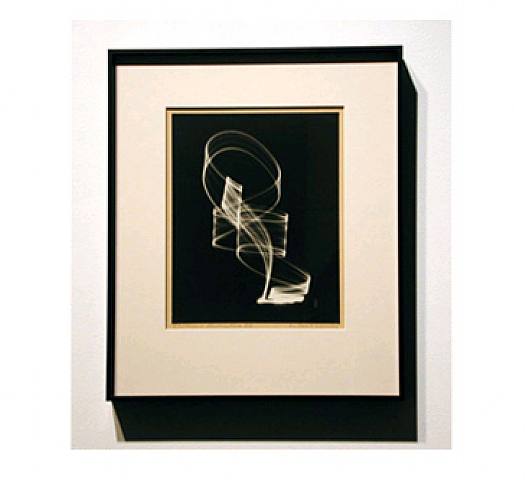
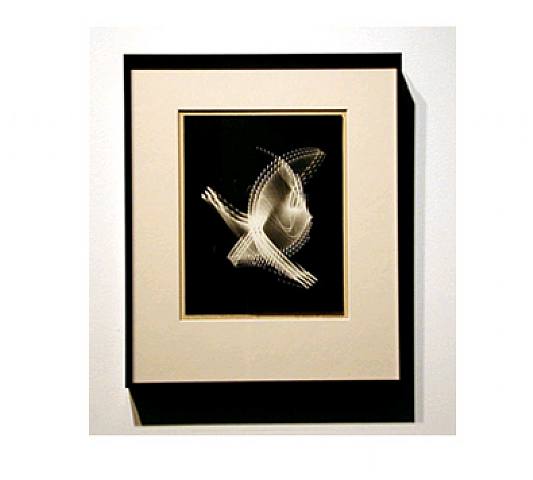
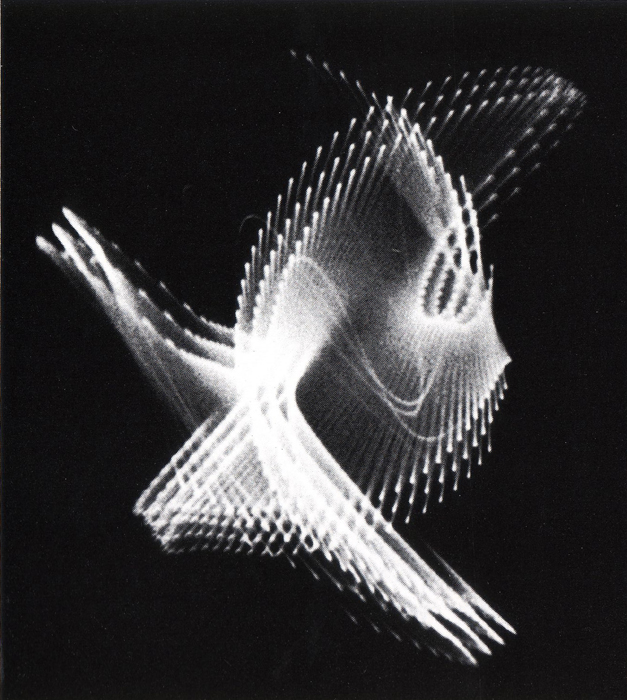 Ben F Laposky (1914, us): Oscillons, 1952-56
V 1950 začína vytvárať prvé grafické obrazce generované elektronickým analógovým počítačom,
osciloskopom. Tvorené vzory lúčov nahráva na vysokorýchlostný film
a z CRT obrazovky potom produkuje fotografie, oscilóny.
-
Ben F Laposky (1914, us): Oscillons, 1952-56
V 1950 začína vytvárať prvé grafické obrazce generované elektronickým analógovým počítačom,
osciloskopom. Tvorené vzory lúčov nahráva na vysokorýchlostný film
a z CRT obrazovky potom produkuje fotografie, oscilóny.
-
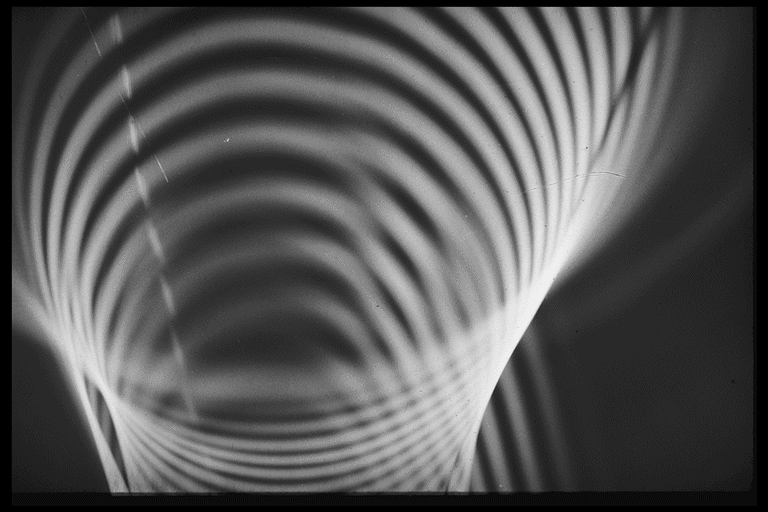
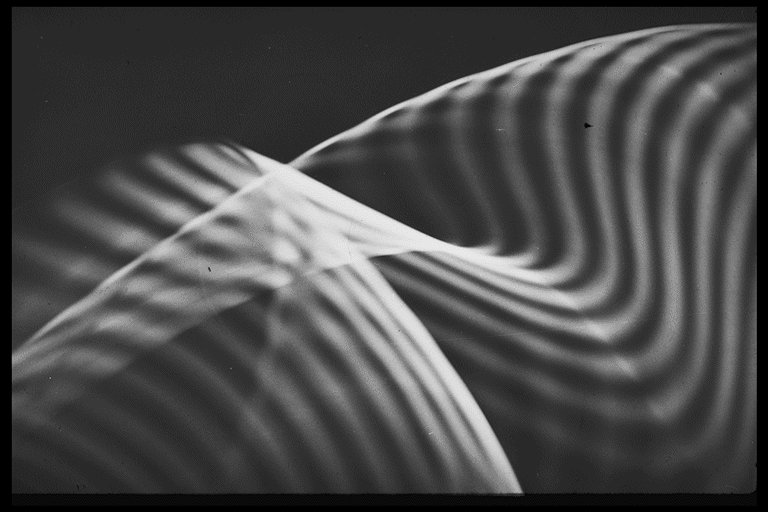
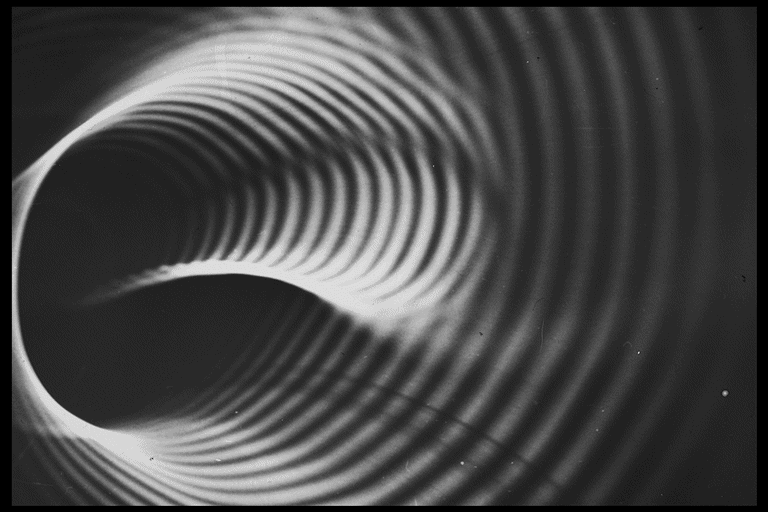
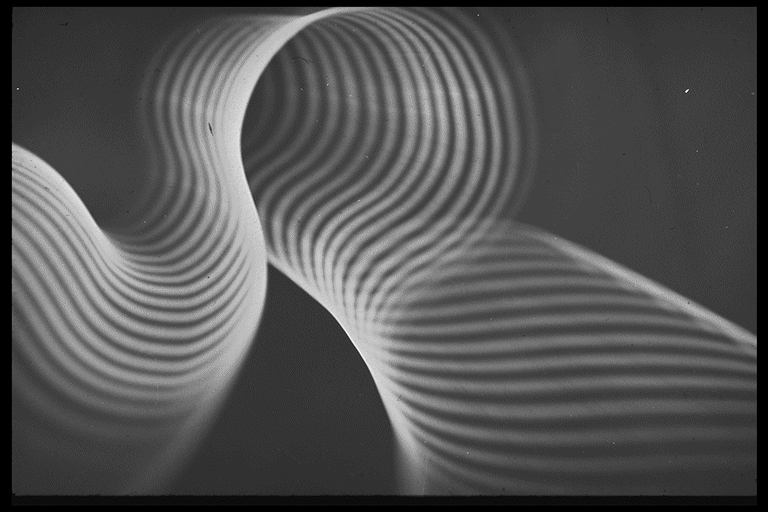 Herbert Franke (1927, de): Lichtformen, 1953-55
S osciloskopom pracuje aj Franke.
It is worth pointing out another coincidence of the development
of computer art in the US and Germany: the first computer art exhibitions
in the world were held in 1965, in the cities of New York and Stuttgart.
Franke's wide-ranging interests include the use of random-number generators,
image-processing, numerically-controlled machine tools, iterative techniques, fractals
and even a series of experiments with music produced on the self-constructed wind instrument
of colleague Bruno Spoerri.
-
Herbert Franke (1927, de): Lichtformen, 1953-55
S osciloskopom pracuje aj Franke.
It is worth pointing out another coincidence of the development
of computer art in the US and Germany: the first computer art exhibitions
in the world were held in 1965, in the cities of New York and Stuttgart.
Franke's wide-ranging interests include the use of random-number generators,
image-processing, numerically-controlled machine tools, iterative techniques, fractals
and even a series of experiments with music produced on the self-constructed wind instrument
of colleague Bruno Spoerri.
-
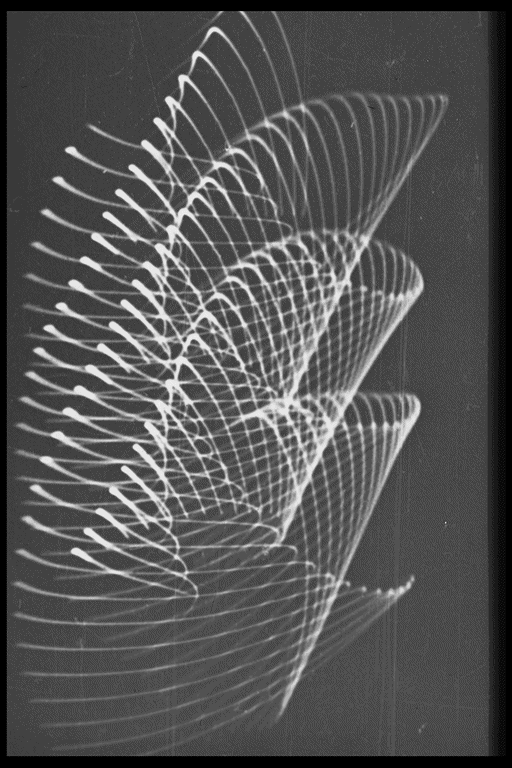 Franke: Oszillogram, 1956
"This little system is a simple analogue computer, specially built by Franz Raimann to help me make
pictures. It is called Oszillogramm because, in principle, the result is the super-position of
two electronic oscillation components. The real picture is in motion, for viewing an old cathode
tube oscilloscope. The photo is a slide made from the screen."
-
Franke: Oszillogram, 1956
"This little system is a simple analogue computer, specially built by Franz Raimann to help me make
pictures. It is called Oszillogramm because, in principle, the result is the super-position of
two electronic oscillation components. The real picture is in motion, for viewing an old cathode
tube oscilloscope. The photo is a slide made from the screen."
-
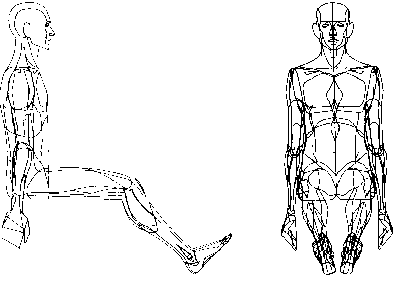 William Fetter, 1960
Fetter coined the term computer graphics to describe one of his own creations:
the first ever computer-generated images of the human figure.
Fetter, an employee of Boeing, was trying to find a way to design an airplane cockpit.
The human model is completed in 1964.
-
William Fetter, 1960
Fetter coined the term computer graphics to describe one of his own creations:
the first ever computer-generated images of the human figure.
Fetter, an employee of Boeing, was trying to find a way to design an airplane cockpit.
The human model is completed in 1964.
-
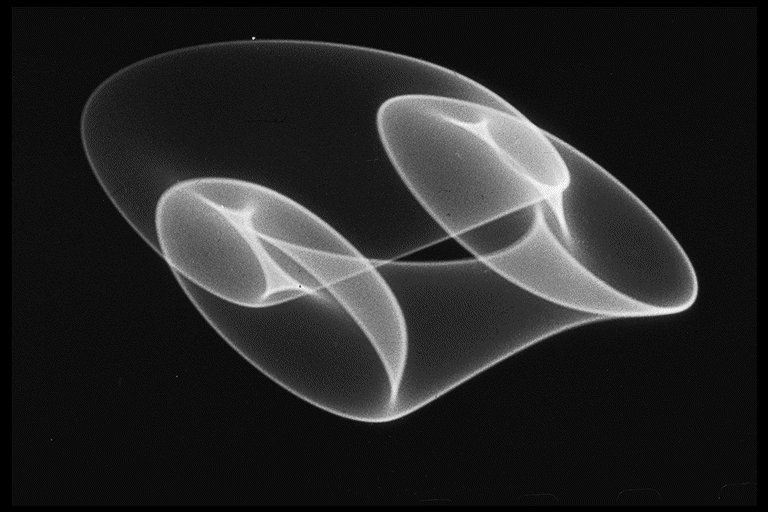
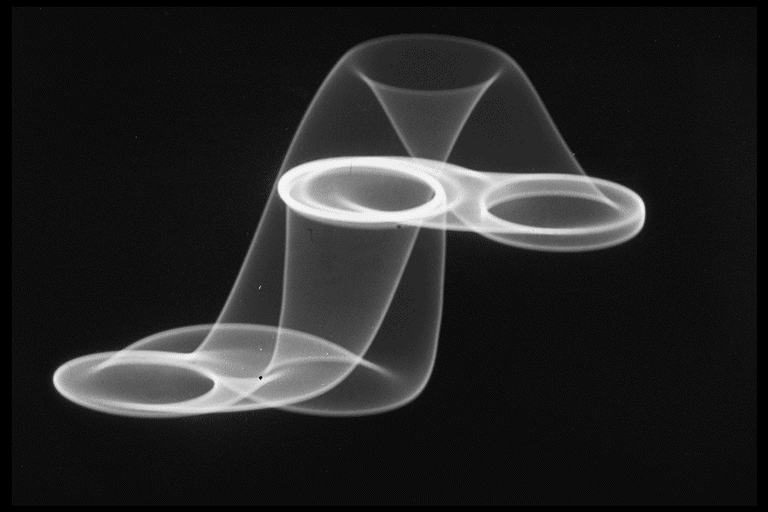
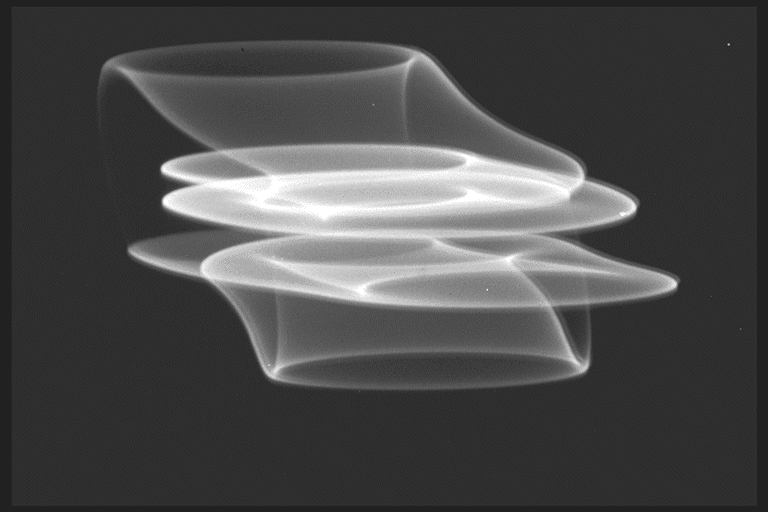
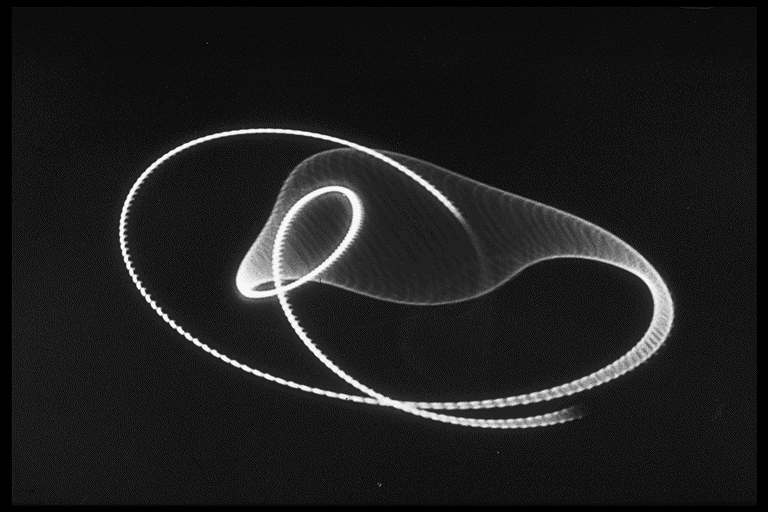 Franke: Electronic Graphics, 1961-62
-
Franke: Electronic Graphics, 1961-62
-
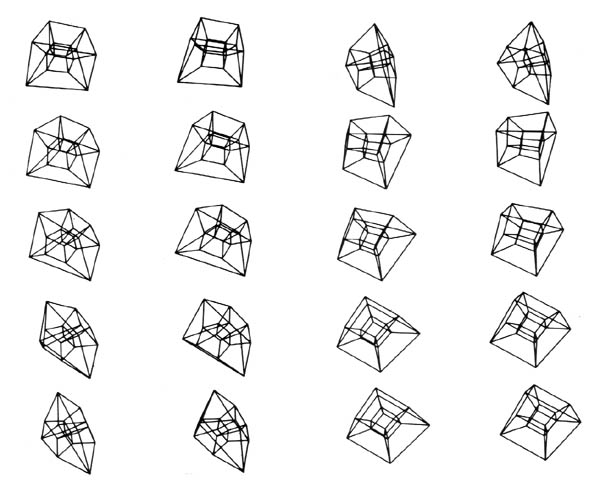 A Michael Noll (us): 3-Dimensional Projection of a Rotating 4-Dimensional Hypercube, 1962
Movie prints (16 mm) of his computer-generated animations.
Noll is one of the earliest pioneers to use a digital computer to create patterns
and animations solely for their artistic and aesthetic value.
First computer works created at Bell Labs in Murray Hill, New Jersey during the Summer of 1962.
-
A Michael Noll (us): 3-Dimensional Projection of a Rotating 4-Dimensional Hypercube, 1962
Movie prints (16 mm) of his computer-generated animations.
Noll is one of the earliest pioneers to use a digital computer to create patterns
and animations solely for their artistic and aesthetic value.
First computer works created at Bell Labs in Murray Hill, New Jersey during the Summer of 1962.
-
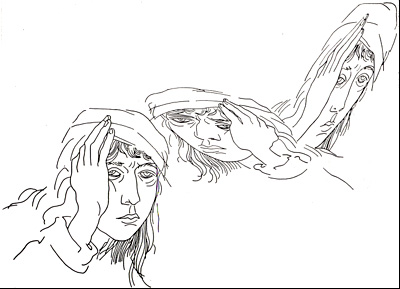
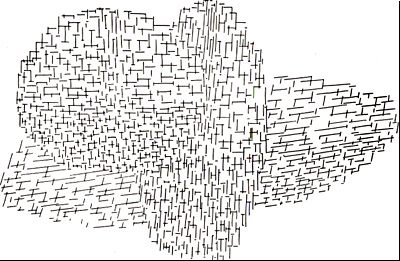 Charles Csuri: After Duerer, 1963
Csuri: After Mondrian, 1963
Csuri experimentuje s figurálnymi motívmi.
"In 1963 I made an analogue computer which I used to make transformations on a drawing. I used it
to do a series of drawings based upon the paintings of several old masters. [Klee, Durer, Ingres,
Picasso, Goya, and Mondrian.]"
-
Charles Csuri: After Duerer, 1963
Csuri: After Mondrian, 1963
Csuri experimentuje s figurálnymi motívmi.
"In 1963 I made an analogue computer which I used to make transformations on a drawing. I used it
to do a series of drawings based upon the paintings of several old masters. [Klee, Durer, Ingres,
Picasso, Goya, and Mondrian.]"
-
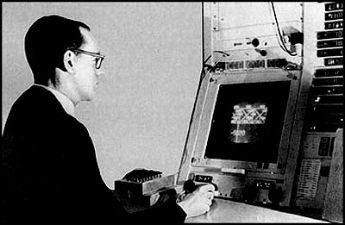 Ivan Sutherland: Sketchpad, 1963
Sutherland created a device which made it possible for people to interactively
create images on their computer screens.
Features:
pop-up menus
constraint-based drawing
hierarchical modeling
utilized lightpen for interaction
-
Ivan Sutherland: Sketchpad, 1963
Sutherland created a device which made it possible for people to interactively
create images on their computer screens.
Features:
pop-up menus
constraint-based drawing
hierarchical modeling
utilized lightpen for interaction
-
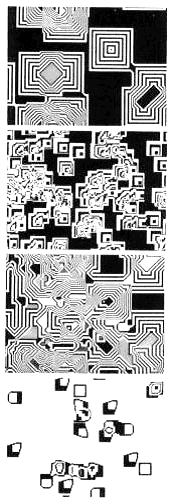 Kenneth Knowlton + Lillian Schwartz (us): Pixillation, 1963
Stills from Pixillation, programmed in BEFLIX.
BEFLIX is the name of the first specialised computer animation language.
BEFLIX was invented by Kenneth C. Knowlton at Bell Telephone Laboratories, USA.
BEFLIX was invented in 1963.
BEFLIX is a corruption of Bell Flicks.
BEFLIX produced images at a resolution of 252 x 184 in 8 shades of grey.
BEFLIX-generated films, created using an IBM 7094 computer and Stromberg-Carlson
4020 microfilm recorder, cost approximately $500 per minute of output.
BEFLIX operations were:
Draw straight lines (from dots).
Draw curves.
Copy region.
Move region.
Solid fill area.
Zoom area.
Dissolve image transition.
Knowlton initially hoped the artists would learn the language to program their own movies,
but he came to realize that they usually wanted to create something the language could
not facilitate, and they also shied away from programming.
Therefore he accommodated the artists by, for example, writing special extensions to BEFLIX
for Stan Vanderbeek, or creating a completely new language, EXPLOR (EXplicit Patterns,
Local Operations and Randomness) for Lillian Schwartz.
-
Kenneth Knowlton + Lillian Schwartz (us): Pixillation, 1963
Stills from Pixillation, programmed in BEFLIX.
BEFLIX is the name of the first specialised computer animation language.
BEFLIX was invented by Kenneth C. Knowlton at Bell Telephone Laboratories, USA.
BEFLIX was invented in 1963.
BEFLIX is a corruption of Bell Flicks.
BEFLIX produced images at a resolution of 252 x 184 in 8 shades of grey.
BEFLIX-generated films, created using an IBM 7094 computer and Stromberg-Carlson
4020 microfilm recorder, cost approximately $500 per minute of output.
BEFLIX operations were:
Draw straight lines (from dots).
Draw curves.
Copy region.
Move region.
Solid fill area.
Zoom area.
Dissolve image transition.
Knowlton initially hoped the artists would learn the language to program their own movies,
but he came to realize that they usually wanted to create something the language could
not facilitate, and they also shied away from programming.
Therefore he accommodated the artists by, for example, writing special extensions to BEFLIX
for Stan Vanderbeek, or creating a completely new language, EXPLOR (EXplicit Patterns,
Local Operations and Randomness) for Lillian Schwartz.
-
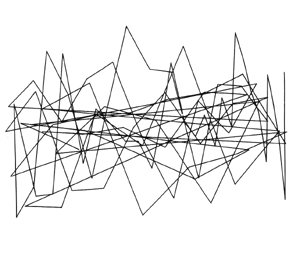
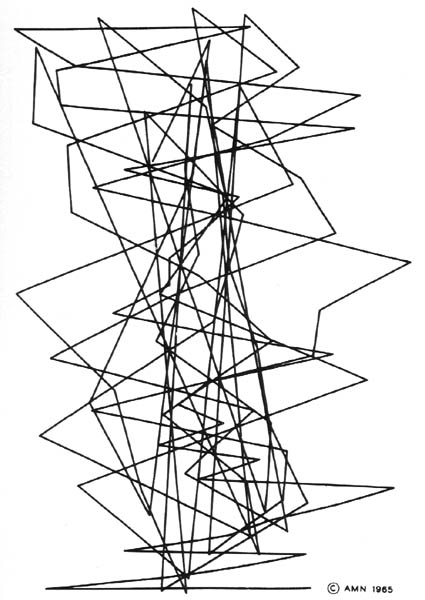 Noll: Gaussian Quadratic, 1963
Ninety-nine lines connect 100 points whose horizontal coordinates are Gaussian.
Vertical coordinates increase according to a quadratic equation.
As a point reaches the top, it is reflected to the bottom to continue its rise.
The exact proportions of this pattern were chosen from many other examples.
www.citi.columbia.edu/amnoll/CompArtExamples.html
Noll: Gaussian Quadratic, 1963
Ninety-nine lines connect 100 points whose horizontal coordinates are Gaussian.
Vertical coordinates increase according to a quadratic equation.
As a point reaches the top, it is reflected to the bottom to continue its rise.
The exact proportions of this pattern were chosen from many other examples.
www.citi.columbia.edu/amnoll/CompArtExamples.html  -
-
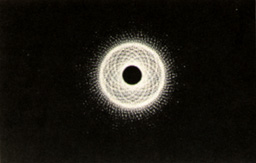
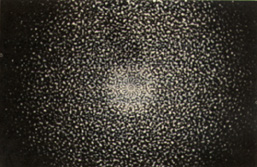
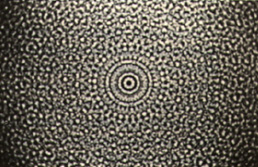
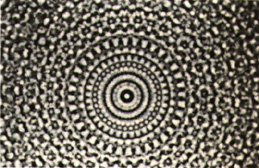 John Whitney sr: Lapis, 1963-66
16mm farebný film Lapis vytvára Whitney na analógovom počítači.
-
John Whitney sr: Lapis, 1963-66
16mm farebný film Lapis vytvára Whitney na analógovom počítači.
-
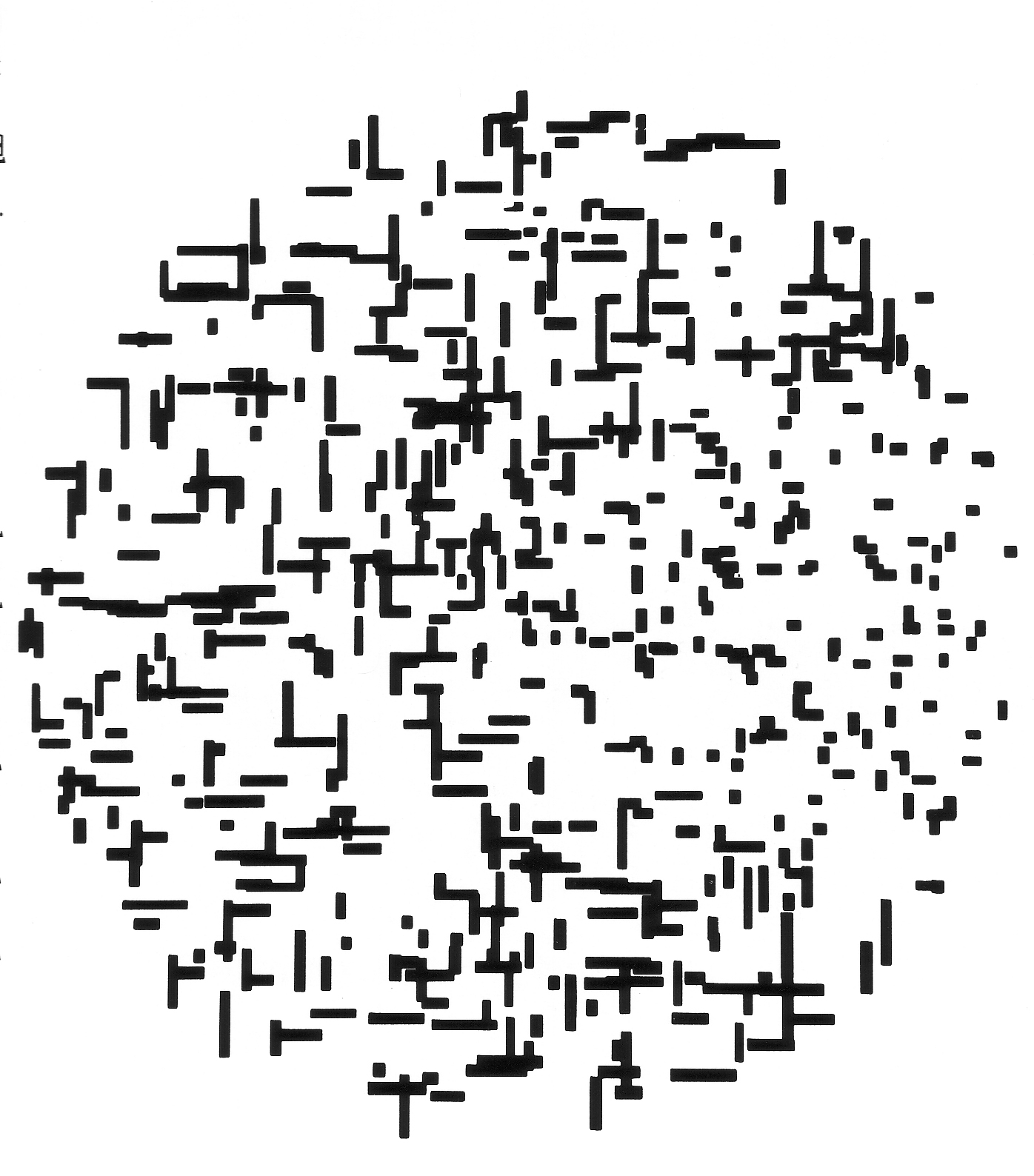
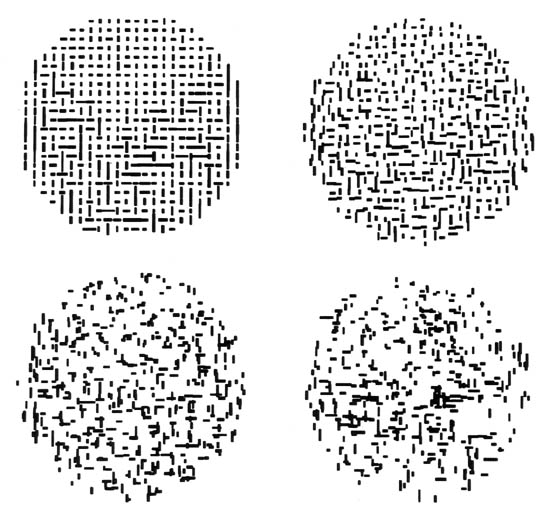 Noll: Computer Composition With Lines, 1964
Noll: Four Computer-Generated Random Patterns Based on the Composition Criteria Of Mondrian's Composition With Lines, 1964
Algorithmic simulation of Mondrian’s painting Composition With Lines
created with pseudorandom numbers.
When xerographic reproductions of both works were shown to 100 people,
the computer-generated picture was preferred to Mondrian by 59.
This early investigation of the aesthetics of computer art has become a classic
and is described in the published paper by Noll,
Human or Machine: A Subjective Comparison of Piet Mondrian's ‘Composition with Lines’
and a Computer–Generated Picture, The Psychological Record, Vol. 16. No. 1,
(January 1966), pp. 1-10.
-
Noll: Computer Composition With Lines, 1964
Noll: Four Computer-Generated Random Patterns Based on the Composition Criteria Of Mondrian's Composition With Lines, 1964
Algorithmic simulation of Mondrian’s painting Composition With Lines
created with pseudorandom numbers.
When xerographic reproductions of both works were shown to 100 people,
the computer-generated picture was preferred to Mondrian by 59.
This early investigation of the aesthetics of computer art has become a classic
and is described in the published paper by Noll,
Human or Machine: A Subjective Comparison of Piet Mondrian's ‘Composition with Lines’
and a Computer–Generated Picture, The Psychological Record, Vol. 16. No. 1,
(January 1966), pp. 1-10.
-
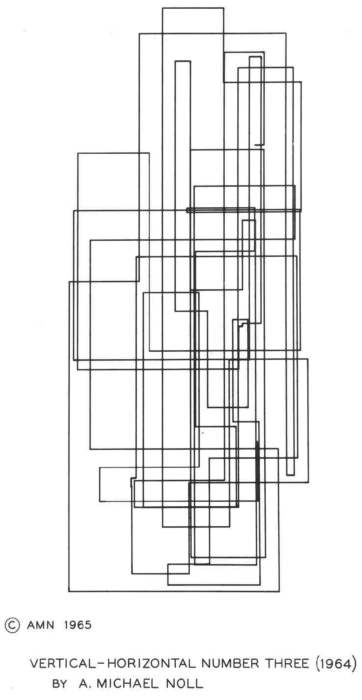 Noll: Vertical-Horizontal No. 3, 1964
The position of the end points of the lines was chosen at random with a uniform probability density.
One of the coordinates was then changed alternately to create horizontal and vertical lines.
-
Noll: Vertical-Horizontal No. 3, 1964
The position of the end points of the lines was chosen at random with a uniform probability density.
One of the coordinates was then changed alternately to create horizontal and vertical lines.
-
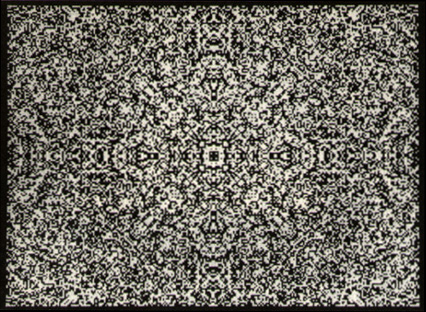 Stan Vanderbeek + Kenneth Knowlton: Poem Fields, 1964
A geometric moving digital tapestry conceived and made entirely on computer.
Made in Bell Labs.
-
1965
First three public exhibitions of computer art:
Feb 5-19, Generative Computergrafik. Studien-Galerie des Studium Generale, Technische Hochschule Stuttgart.
held by Frieder Nake and Georg Nees (de).
Opened by Max Bense (de).
Apr 6-24, Computer-generated pictures. Howard Wise Gallery, New York (us)
held by A Michael Noll, Bela Julesz (both Bell Labs).
Nov 5-26, Computergrafik. Galerie Wendelin Niedlich, Stuttgart.
held by Frieder Nake and Georg Nees (de).
Opened by Max Bense (de)
Vystavujú nie profesionálni umelci, ale matematici a programátori.
Prácami sú najmä paralely k dielam konštruktivistov, suprematistov či op-artu.
-
Stan Vanderbeek + Kenneth Knowlton: Poem Fields, 1964
A geometric moving digital tapestry conceived and made entirely on computer.
Made in Bell Labs.
-
1965
First three public exhibitions of computer art:
Feb 5-19, Generative Computergrafik. Studien-Galerie des Studium Generale, Technische Hochschule Stuttgart.
held by Frieder Nake and Georg Nees (de).
Opened by Max Bense (de).
Apr 6-24, Computer-generated pictures. Howard Wise Gallery, New York (us)
held by A Michael Noll, Bela Julesz (both Bell Labs).
Nov 5-26, Computergrafik. Galerie Wendelin Niedlich, Stuttgart.
held by Frieder Nake and Georg Nees (de).
Opened by Max Bense (de)
Vystavujú nie profesionálni umelci, ale matematici a programátori.
Prácami sú najmä paralely k dielam konštruktivistov, suprematistov či op-artu.
-
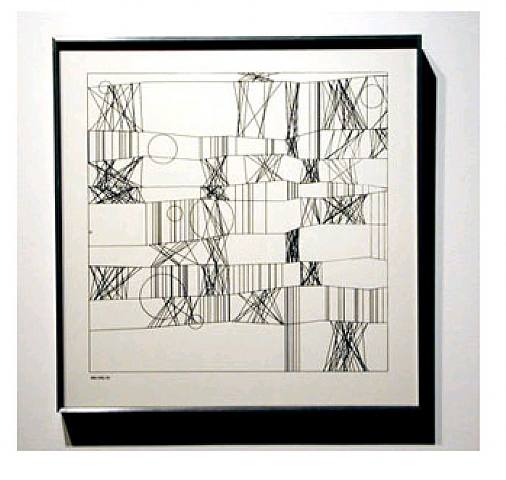
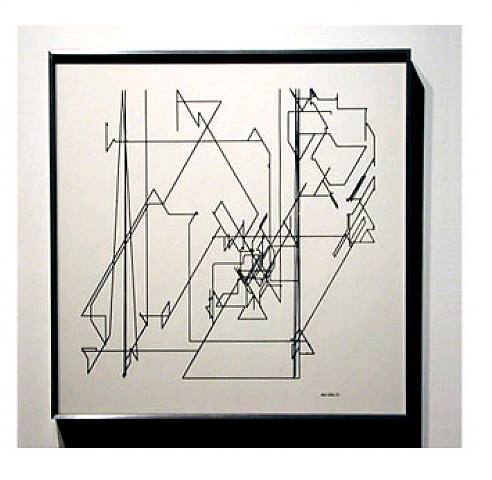 Frieder Nake: 13/9/1965, Nr 2 & 7, 1965
As a student of mathematics, he was interested in probability theory, and in random numbers in particular.
During that time, he visited philosopher Max Bense from whom he was influenced by.
His interest in philosophy and mathematics began to merge as he started to experiment with drawing software.
Vytvára paralely k dielam Hansa Hartunga a Paula Kleeho.
One of the works shown at the Stuttgart exhibition was entitled Homage a Paul Klee.
Klee’s drawings inspired him to think about programming visual art as a tension between macro and
microaesthetics. They were based on linear structural elements that stretched out across the entire
format but also allowed for smaller groups and gatherings of intricate local graphics.
Nake developed the language COMPARTER ER 56 referring to the Standard Elektric ER 56 computer,
for which it was written. ER 56 contained three subpackages, a space organizer, a set of different
random number generators, and selectors for the repertoire of graphic elements.
Program chose a stochastic matrix, raised the quantities to powers,
and then visualized the numerical results by allocating characters or colours according to their amount.
-
Frieder Nake: 13/9/1965, Nr 2 & 7, 1965
As a student of mathematics, he was interested in probability theory, and in random numbers in particular.
During that time, he visited philosopher Max Bense from whom he was influenced by.
His interest in philosophy and mathematics began to merge as he started to experiment with drawing software.
Vytvára paralely k dielam Hansa Hartunga a Paula Kleeho.
One of the works shown at the Stuttgart exhibition was entitled Homage a Paul Klee.
Klee’s drawings inspired him to think about programming visual art as a tension between macro and
microaesthetics. They were based on linear structural elements that stretched out across the entire
format but also allowed for smaller groups and gatherings of intricate local graphics.
Nake developed the language COMPARTER ER 56 referring to the Standard Elektric ER 56 computer,
for which it was written. ER 56 contained three subpackages, a space organizer, a set of different
random number generators, and selectors for the repertoire of graphic elements.
Program chose a stochastic matrix, raised the quantities to powers,
and then visualized the numerical results by allocating characters or colours according to their amount.
-
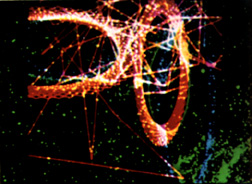
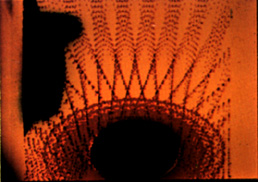
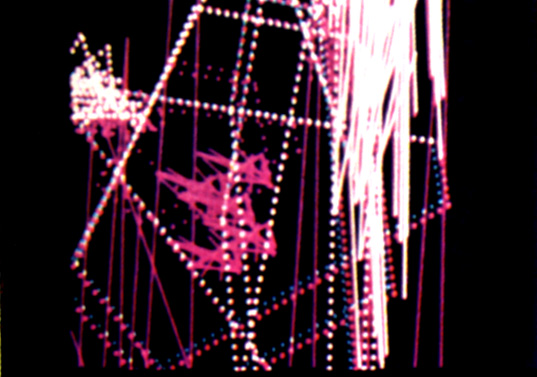 John Stehura: Cybernetik 5.3, 1965-69
Film realised entirely using programming.
-
John Stehura: Cybernetik 5.3, 1965-69
Film realised entirely using programming.
-
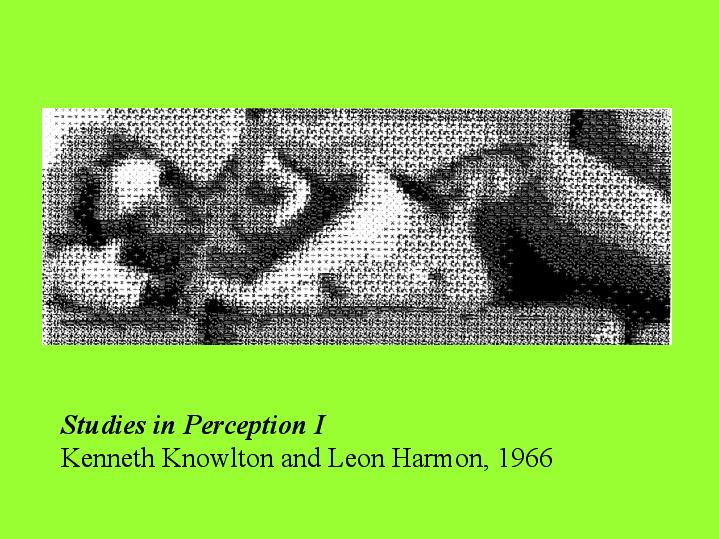 Kenneth Knowlton + Leon Harmon: Studies in Perception I, 1966
Automatic digitizing method for images.
Created in Bell Labs, early example of image processing, probably the first computer nude.
Knowlton and Harmon scanned a photograph with a special camera, converted analog voltages
to binary numbers, which were stored on magnetic tape.
Another program assigned typographic symbols to these numbers according to halftone densities.
Finally printed by a microfilm plotter.
Exhibited in The Machine show in MoMA in 1968.
-
Kenneth Knowlton + Leon Harmon: Studies in Perception I, 1966
Automatic digitizing method for images.
Created in Bell Labs, early example of image processing, probably the first computer nude.
Knowlton and Harmon scanned a photograph with a special camera, converted analog voltages
to binary numbers, which were stored on magnetic tape.
Another program assigned typographic symbols to these numbers according to halftone densities.
Finally printed by a microfilm plotter.
Exhibited in The Machine show in MoMA in 1968.
-
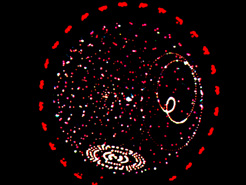
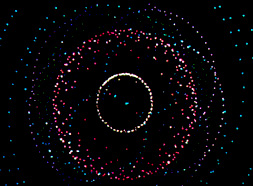
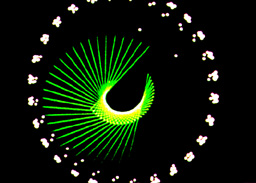 Whitney: Permutations, 1967
Film constructed entirely off the black-and-white monitor of a large computer system
(IBM 360, IBM 2250 Display, written in GRAF and FORTRAN).
Color was added by editing with an optical printer.
It is an elegant abstract work composed of architectures of color dots that develop pattern
while displaying a kinetic rhythm.
-
1968
August 2 - October 20
Cybernetic Serendipity: The Computer and the Arts exhibition is held
at the Institute of Contemporary Art, London,
curated by Jasia Reichardt (ICA director)
and advised by Max Bense.
Exhibition draws 60,000 people in 2 months.
Works include plotter drawings, computer prints, verses, films, sculpture, music and robots.
Three sections:
1st consisted of computer generated graphics, computer animated films, computer composed and played music, and computer verse and texts.
2nd included machines.
3rd included machines demonstrating the uses of computers.
Some More Beginnings show is organized by Experiments in Art and Technology
at the Brooklyn Museum, New York.
-
1968
First two international computer art exhibitions in Czechoslovakia:
Brno, organised by Jiri Valoch (1946, experimental poet),
Počítač a umění, Filmový klub, Praha, organised by Miroslav Klivar (1932)
-
Whitney: Permutations, 1967
Film constructed entirely off the black-and-white monitor of a large computer system
(IBM 360, IBM 2250 Display, written in GRAF and FORTRAN).
Color was added by editing with an optical printer.
It is an elegant abstract work composed of architectures of color dots that develop pattern
while displaying a kinetic rhythm.
-
1968
August 2 - October 20
Cybernetic Serendipity: The Computer and the Arts exhibition is held
at the Institute of Contemporary Art, London,
curated by Jasia Reichardt (ICA director)
and advised by Max Bense.
Exhibition draws 60,000 people in 2 months.
Works include plotter drawings, computer prints, verses, films, sculpture, music and robots.
Three sections:
1st consisted of computer generated graphics, computer animated films, computer composed and played music, and computer verse and texts.
2nd included machines.
3rd included machines demonstrating the uses of computers.
Some More Beginnings show is organized by Experiments in Art and Technology
at the Brooklyn Museum, New York.
-
1968
First two international computer art exhibitions in Czechoslovakia:
Brno, organised by Jiri Valoch (1946, experimental poet),
Počítač a umění, Filmový klub, Praha, organised by Miroslav Klivar (1932)
-
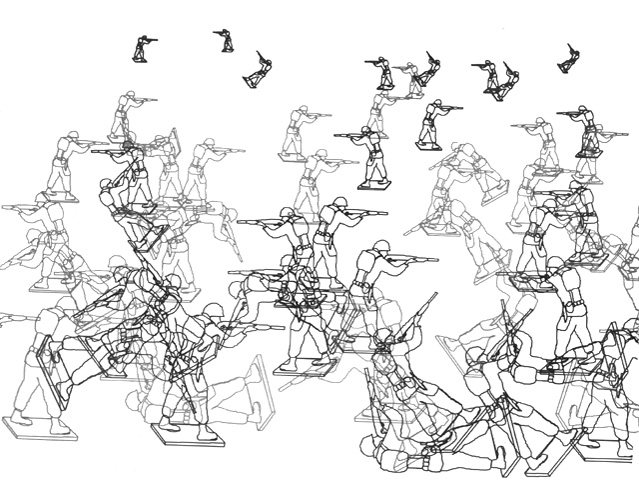 Csuri: Random War, 1968
"A drawing was made of a single toy soldier and this became a data set. The computer program
used a random number generator. The random numbers determined the distribution and position of
400 soldiers on a battlefield. A transformatation involving rotations was used to determine the
angle of each soldier. One side was called the 'Red' and the other one the 'Black' and the names
of real people were given to the program. Another program assigned military rands and army serial
numbers also at random. The random number generator decided the following information.
(1) Dead
(2) Wounded
(3) Missing
(4) Survivors
(5) One Hero for Each Side
(6) Medals for Valor
(7) Good Conduct
(8) Efficiency Medals"
-
Csuri: Random War, 1968
"A drawing was made of a single toy soldier and this became a data set. The computer program
used a random number generator. The random numbers determined the distribution and position of
400 soldiers on a battlefield. A transformatation involving rotations was used to determine the
angle of each soldier. One side was called the 'Red' and the other one the 'Black' and the names
of real people were given to the program. Another program assigned military rands and army serial
numbers also at random. The random number generator decided the following information.
(1) Dead
(2) Wounded
(3) Missing
(4) Survivors
(5) One Hero for Each Side
(6) Medals for Valor
(7) Good Conduct
(8) Efficiency Medals"
-
 Csuri: Aging Process, 1968
"Two drawings were digitized, one of a young girl and the other of an old woman. The program
starts with the young girl and then in stages moves it toward the older woman. Gradually the
drawing is fragmented with a greater displacement as it reaches the center. Then the fragments
begin to incrementally change their shape until the drawing of the woman is realized. This process
was used to create a short animation sequence and it was probably more effective as an animation
rather than a still image."
-
Csuri: Aging Process, 1968
"Two drawings were digitized, one of a young girl and the other of an old woman. The program
starts with the young girl and then in stages moves it toward the older woman. Gradually the
drawing is fragmented with a greater displacement as it reaches the center. Then the fragments
begin to incrementally change their shape until the drawing of the woman is realized. This process
was used to create a short animation sequence and it was probably more effective as an animation
rather than a still image."
-
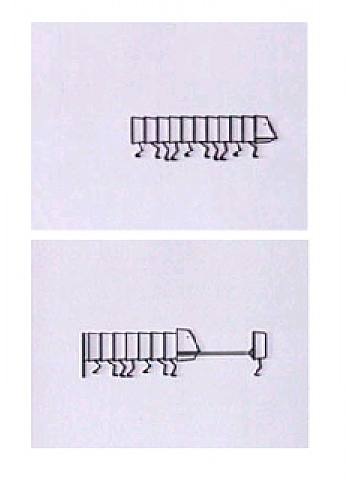 Tony Pritchett: Flexipede, 1968
One of the first examples of digital film.
It took several months to make during 1966 and 67,
using the London University Atlas computer (a supercomputer in those days, with 128K of online memory),
programmed in Fortran on punched cards with a 2-hour turn-around time,
and output on the first microfilm recorder in the UK.
The microfilm recorder was only capable of drawing black lines on to a square area of the film frame,
which accounts for its rather restricted graphic style.
-
Tony Pritchett: Flexipede, 1968
One of the first examples of digital film.
It took several months to make during 1966 and 67,
using the London University Atlas computer (a supercomputer in those days, with 128K of online memory),
programmed in Fortran on punched cards with a 2-hour turn-around time,
and output on the first microfilm recorder in the UK.
The microfilm recorder was only capable of drawing black lines on to a square area of the film frame,
which accounts for its rather restricted graphic style.
-
.gif) Georg Nees: Wurfel-Unordnung (Cubic Disarray), 1968-71
Nees' plotter piece remains a poetically elegant computer graphic rendering of order and chaos.
-
Georg Nees: Wurfel-Unordnung (Cubic Disarray), 1968-71
Nees' plotter piece remains a poetically elegant computer graphic rendering of order and chaos.
-
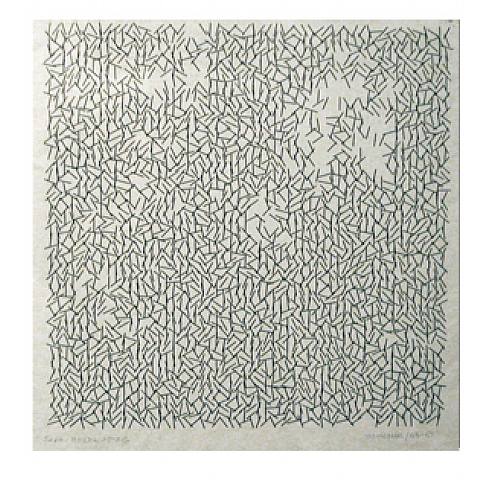 Vera Molnar (1924, hu): Interruptions, 1968-69
In 1968, she began using a computer to assist her art making.
She creates non-figurative, geometric drawings by using computer and pen plotter.
The computer’s ability to produce an infinite number of random and calculated images and record them
would provide artists with enormous data bank for creativity.
Just like the traditional painter, Klee and Kandinsky tried to visualize the hidden force in nature
or in their mind, Molnar believes the computer could help artist reveal the hidden force
behind their creativity.
-
Vera Molnar (1924, hu): Interruptions, 1968-69
In 1968, she began using a computer to assist her art making.
She creates non-figurative, geometric drawings by using computer and pen plotter.
The computer’s ability to produce an infinite number of random and calculated images and record them
would provide artists with enormous data bank for creativity.
Just like the traditional painter, Klee and Kandinsky tried to visualize the hidden force in nature
or in their mind, Molnar believes the computer could help artist reveal the hidden force
behind their creativity.
-
.jpg)
.jpg) Edward Zajec (1938, IT): Prostor p1 v13 & v19, 1969-70
The Prostor series implement a balanced interplay
between the deterministic and random parts,
and aim to avoid the tile-effect so common in compositions based on a rectangular grid.
pri každom spustení programu je východiskovou štruktúrou prázdny štvorec,
ktorý program člení podľa vložených harmonických proporcií.
vnútro štvorca sa vypĺňa štyrmi základnými elementami –
vertikálnou, horizontálnou, diagonálnou líniou a sínusovou krivkou.
dĺžka a nadväznosť segmentov je určená na základe pravidiel.
Each time program runs, it defines a rectangle and subdivides it according to harmonic proportions.
The figure formation inside this composition takes place by selecting successively a line
from this set: vertical, horizontal, diagonal and sinusoidal.
The parameters for length and amplitude comply with harmonic ratios.
The lines connect with each other according to predetermined rules.
-
Edward Zajec (1938, IT): Prostor p1 v13 & v19, 1969-70
The Prostor series implement a balanced interplay
between the deterministic and random parts,
and aim to avoid the tile-effect so common in compositions based on a rectangular grid.
pri každom spustení programu je východiskovou štruktúrou prázdny štvorec,
ktorý program člení podľa vložených harmonických proporcií.
vnútro štvorca sa vypĺňa štyrmi základnými elementami –
vertikálnou, horizontálnou, diagonálnou líniou a sínusovou krivkou.
dĺžka a nadväznosť segmentov je určená na základe pravidiel.
Each time program runs, it defines a rectangle and subdivides it according to harmonic proportions.
The figure formation inside this composition takes place by selecting successively a line
from this set: vertical, horizontal, diagonal and sinusoidal.
The parameters for length and amplitude comply with harmonic ratios.
The lines connect with each other according to predetermined rules.
-
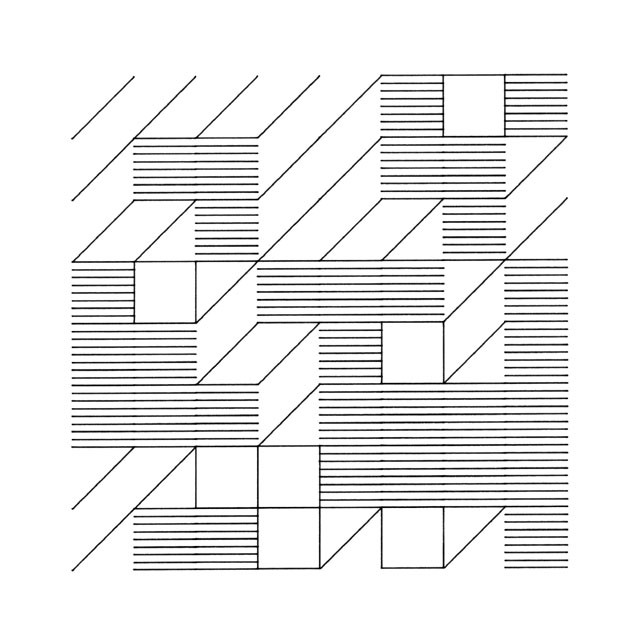
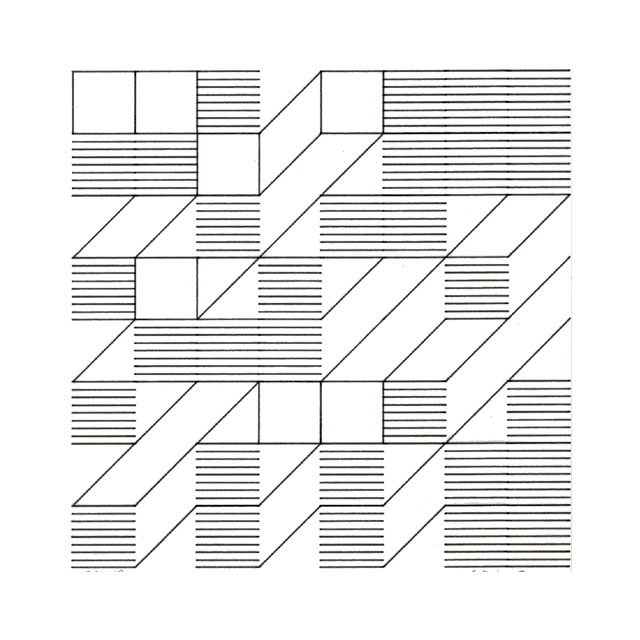
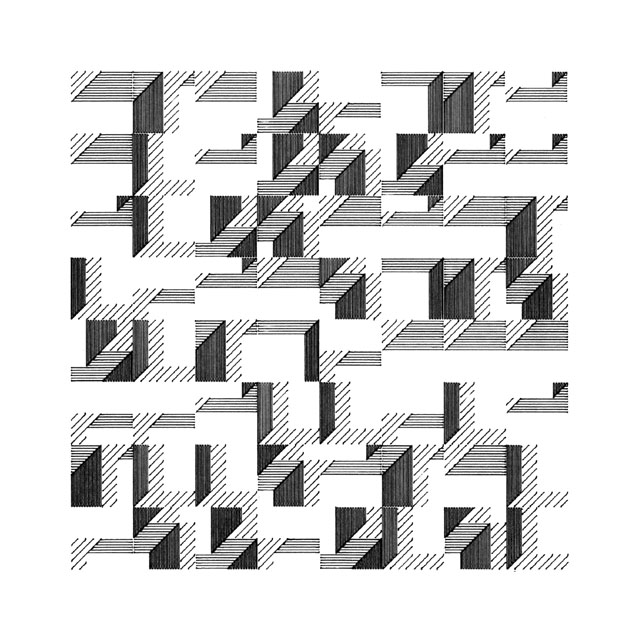
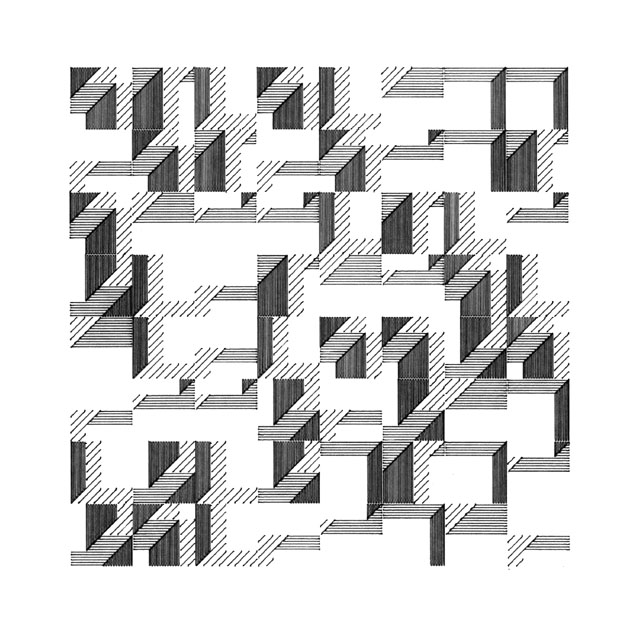 Zajec: RAM 10/3, 10/4, 2/6, 2/9, 1969
The RAM compositions are examples of Zajec's first work done on an IBM 1620 computer.
Linear elements are distributed on a rectangular lattice in different spatial and rhythmic
combinations according to varying probabilities of occurrence.
-
Zajec: RAM 10/3, 10/4, 2/6, 2/9, 1969
The RAM compositions are examples of Zajec's first work done on an IBM 1620 computer.
Linear elements are distributed on a rectangular lattice in different spatial and rhythmic
combinations according to varying probabilities of occurrence.
-
Series.gif)
Series.2.gif) Franke + Peter Henne: CAES (Curves, aesthetics), 1969
-
Franke + Peter Henne: CAES (Curves, aesthetics), 1969
-
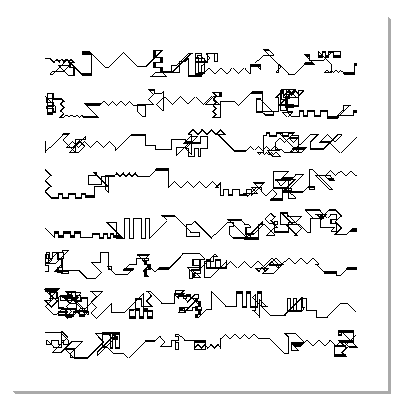
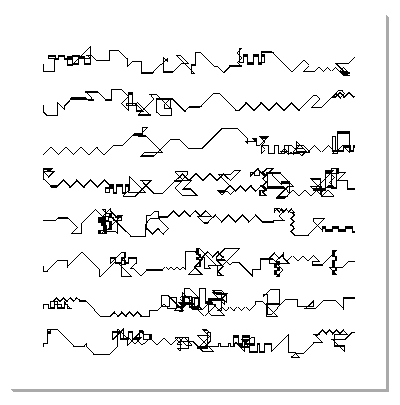
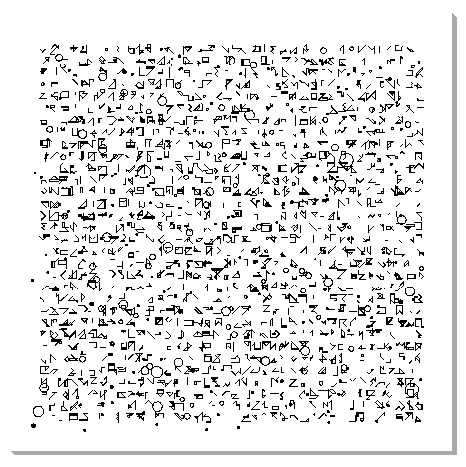
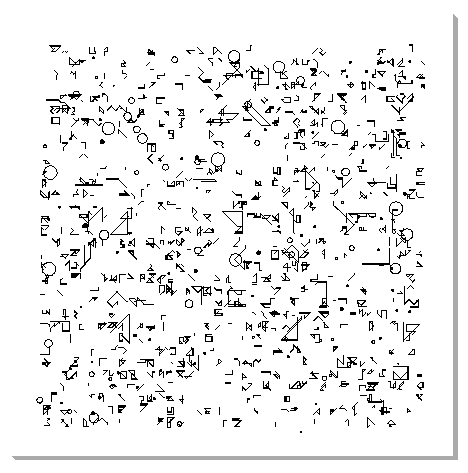 Manfred Mohr (1938, de): P-021/A & P-021/B, Scratch Code, 1969
Mohr: P-049/R & P-050/R, 1970
With this work phase (1969-72), a logical and automatic construction of pictures is introduced into
Mohr's work. For the first time algorithms (rules with a beginning and an ending) are used to calculate
the images.
Individual algorithms are invented for each work from which all forms and structures are solely
generated. The algorithms are built from imposed as well as from random selection principles which
Mohr calls aesthetical-filters.
www.dam.org/mohr/artworks.htm
Manfred Mohr (1938, de): P-021/A & P-021/B, Scratch Code, 1969
Mohr: P-049/R & P-050/R, 1970
With this work phase (1969-72), a logical and automatic construction of pictures is introduced into
Mohr's work. For the first time algorithms (rules with a beginning and an ending) are used to calculate
the images.
Individual algorithms are invented for each work from which all forms and structures are solely
generated. The algorithms are built from imposed as well as from random selection principles which
Mohr calls aesthetical-filters.
www.dam.org/mohr/artworks.htm  -
-
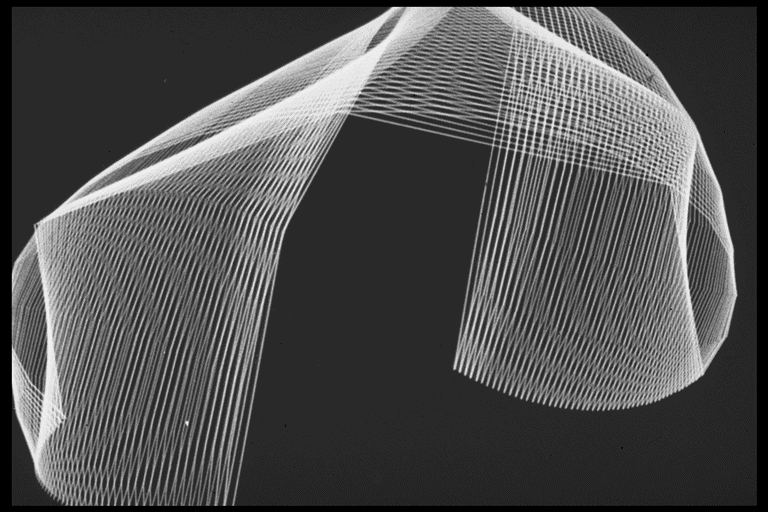
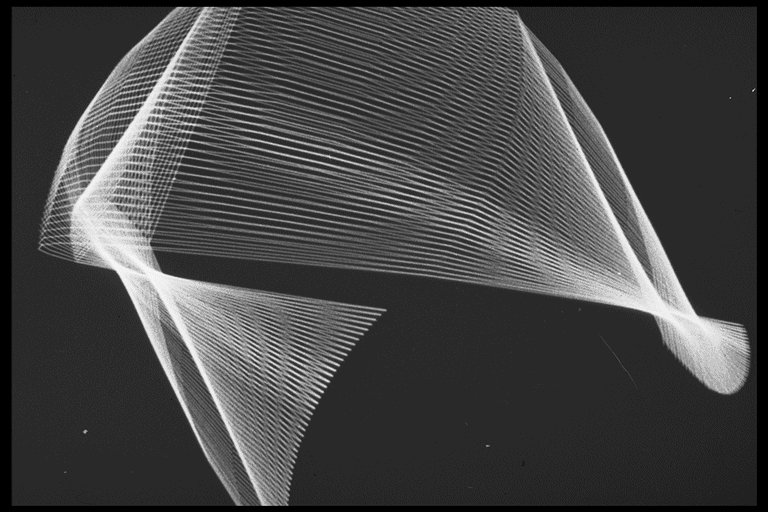
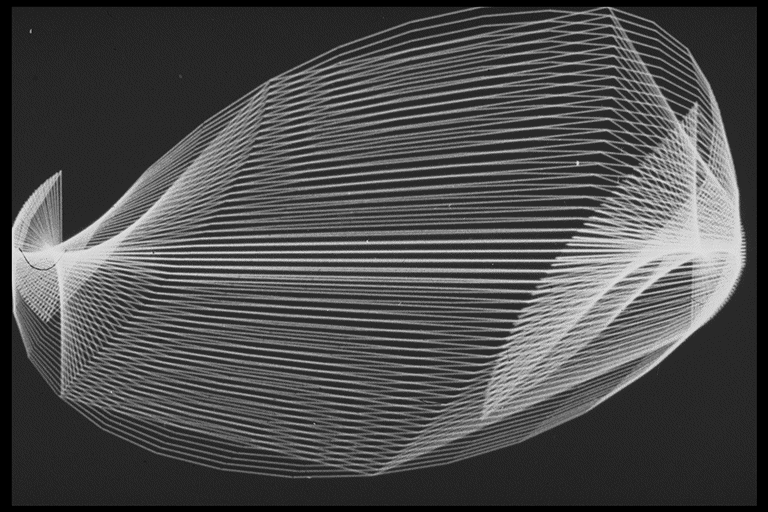
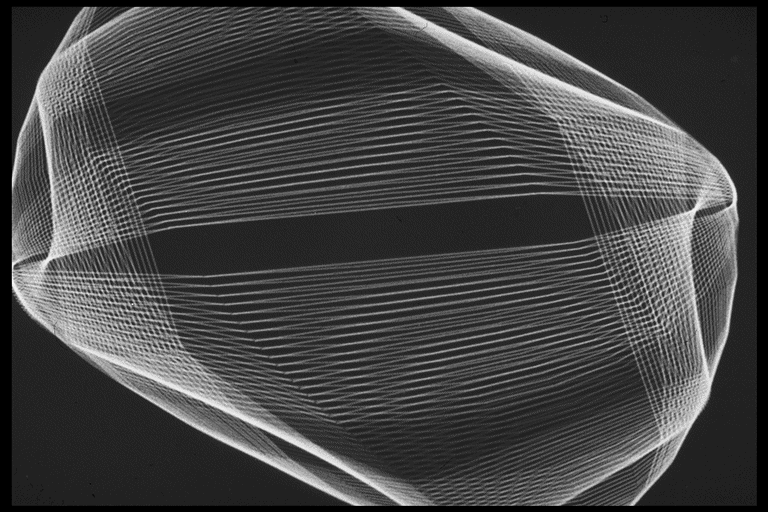 Franke: Rotationen, Projection, 1970-71
The images are based on interactively controlled motions in perspective view.
This kind of animation sequences were used for the Laser ballet which
was performed on the experimental stage of the bavarian state opera.
-
1971
Worlds first museum based solo exhibition of computer generated art;
Manfred Mohr, Musee d'Art Moderne de la Ville de Paris (France)
-
Franke: Rotationen, Projection, 1970-71
The images are based on interactively controlled motions in perspective view.
This kind of animation sequences were used for the Laser ballet which
was performed on the experimental stage of the bavarian state opera.
-
1971
Worlds first museum based solo exhibition of computer generated art;
Manfred Mohr, Musee d'Art Moderne de la Ville de Paris (France)
-
.jpg)
.jpg)
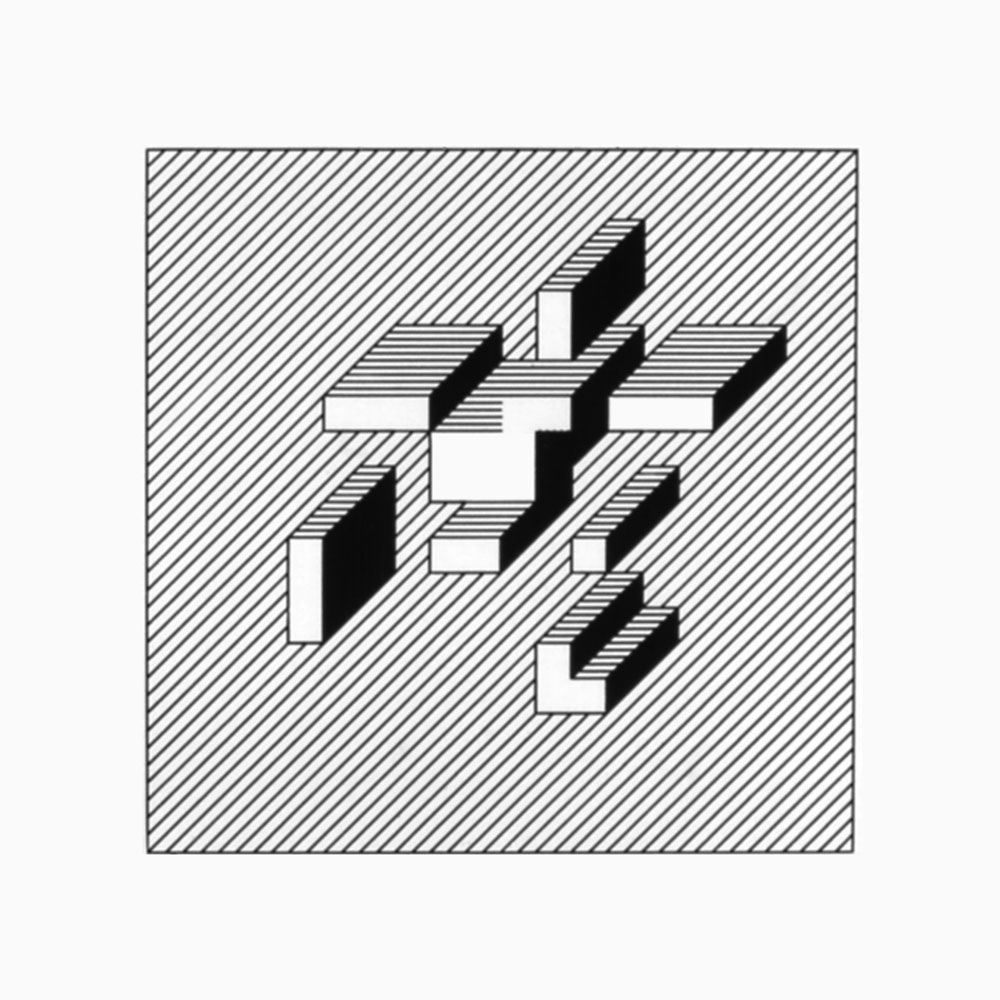
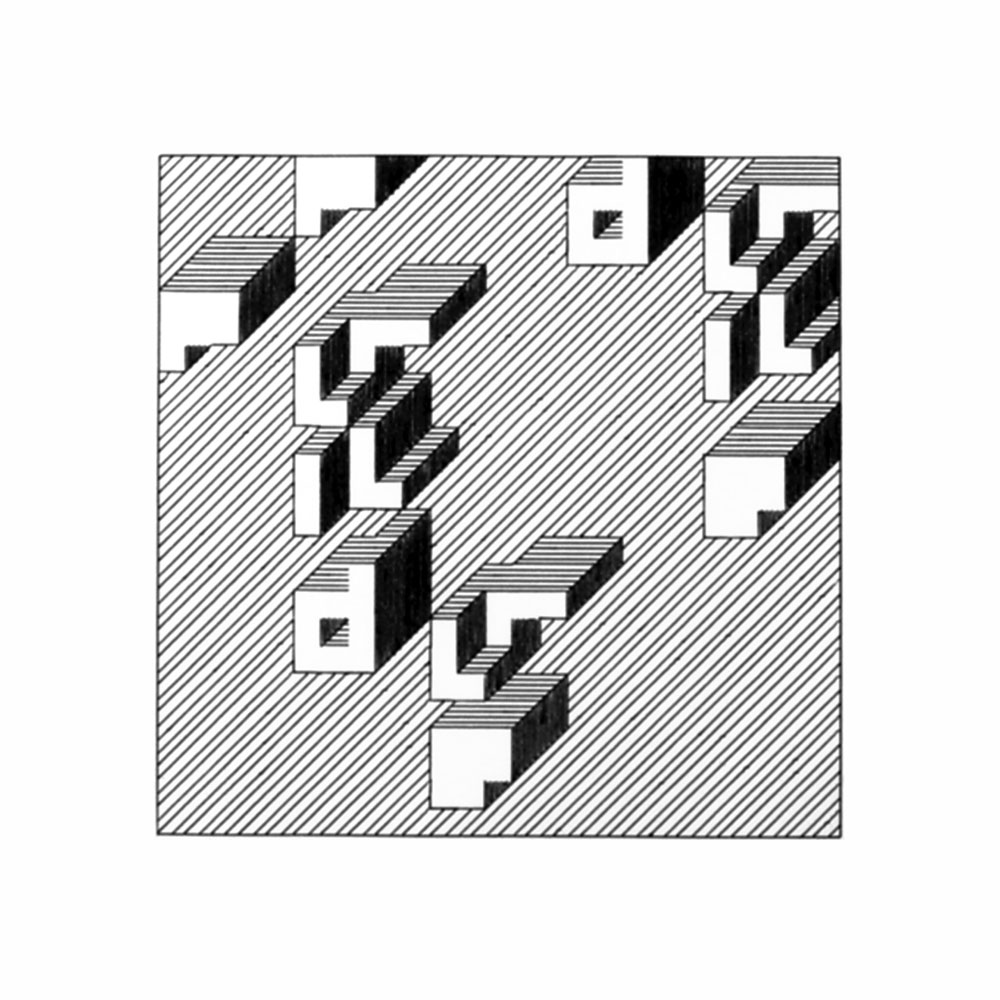
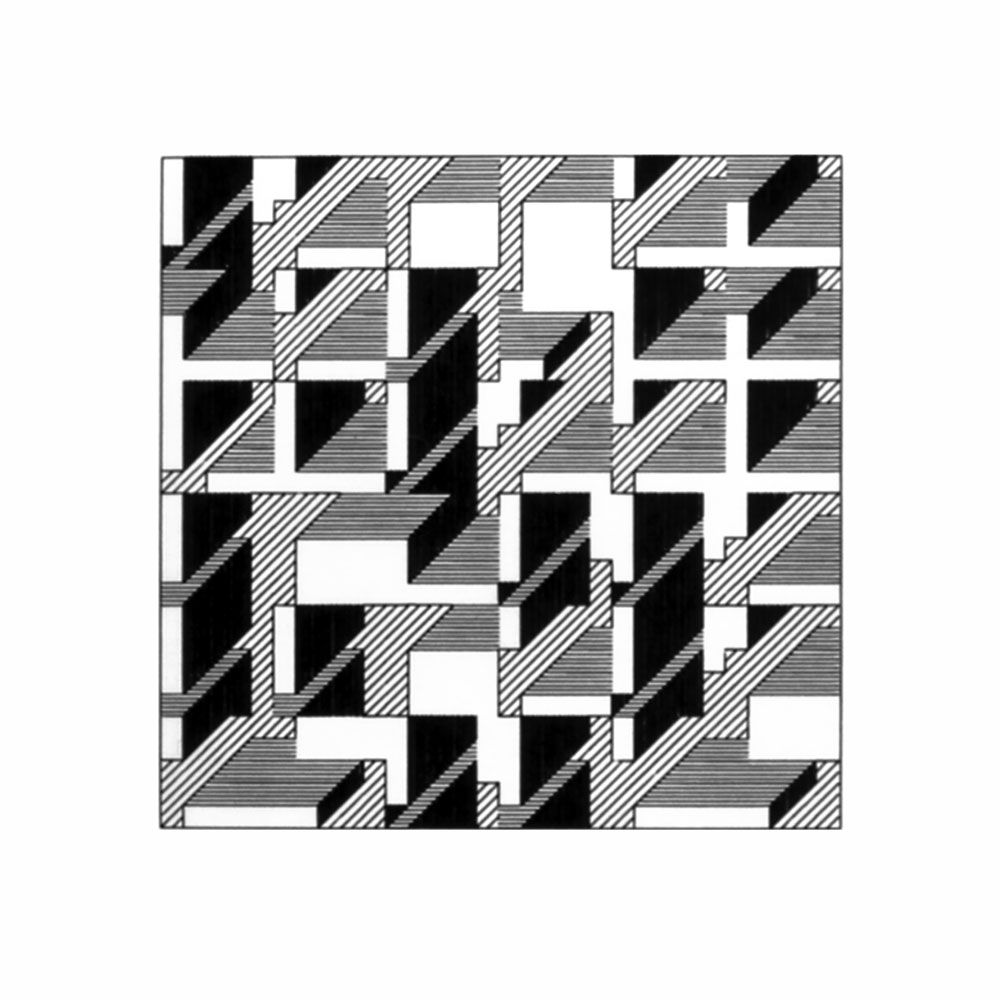
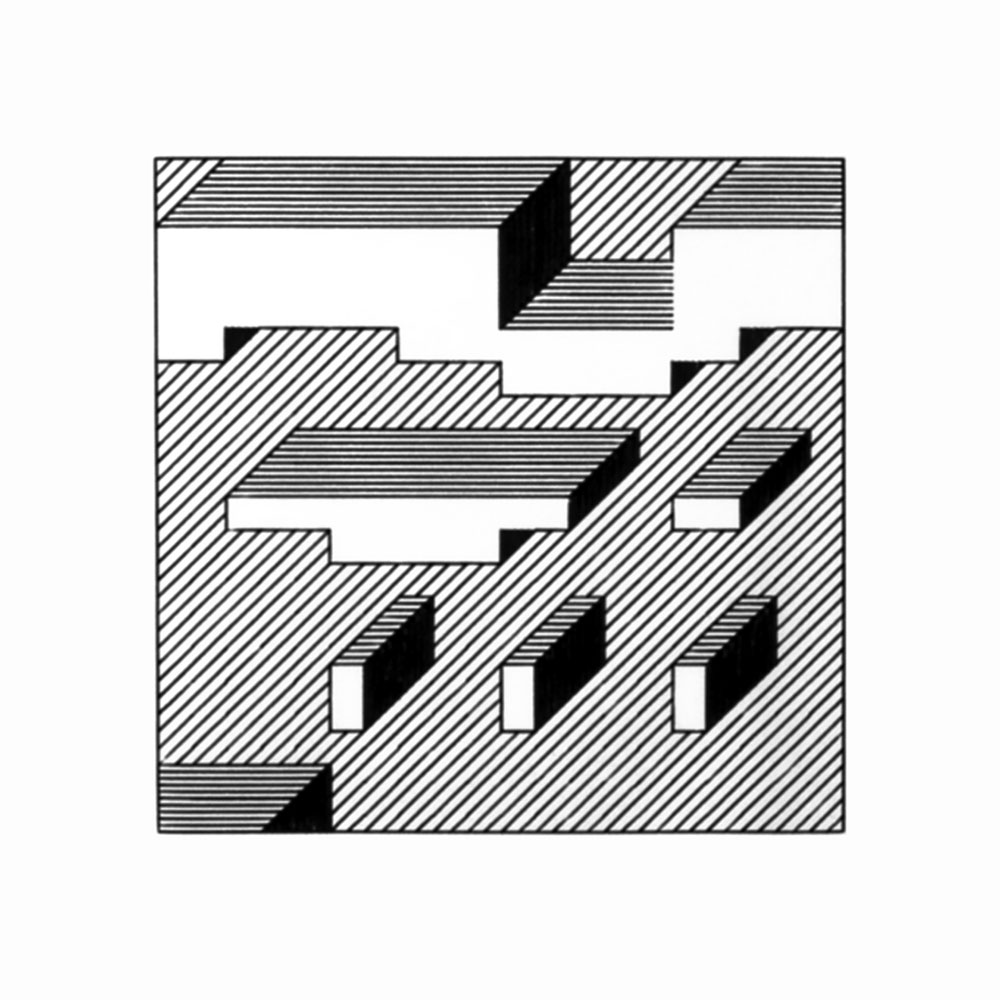
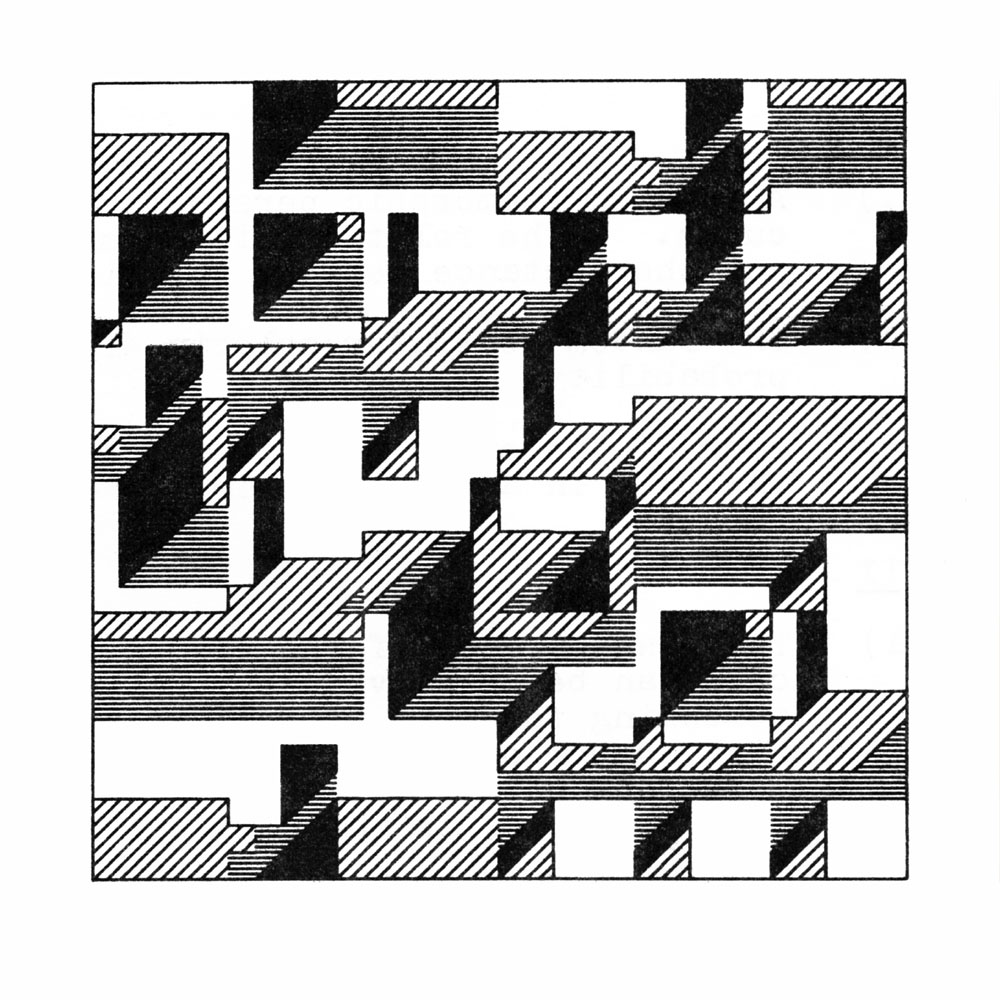 Zajec: TVC, 1971
In TVC, the main subject of invention is no longer the design of visual modules, but of procedural ones.
The focus is no longer on the geometry of projection,
but on the grammatical rules that delimit the possible combinations of the constituent elements.
-
Zajec: TVC, 1971
In TVC, the main subject of invention is no longer the design of visual modules, but of procedural ones.
The focus is no longer on the geometry of projection,
but on the grammatical rules that delimit the possible combinations of the constituent elements.
-
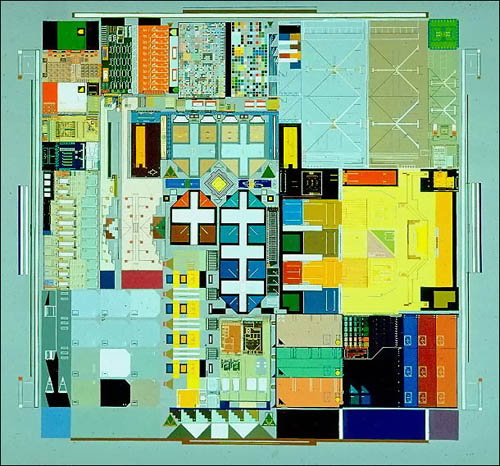
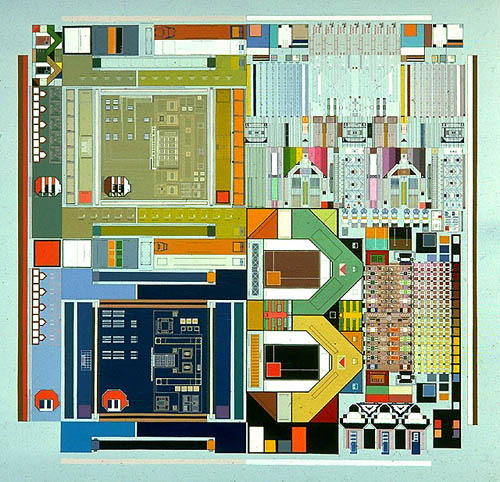 Mark Wilson: Untitled Gray Ground & Untitled Light Gray Ground, 1973
abstract painting involved with complex geometric imagery.
-
Mark Wilson: Untitled Gray Ground & Untitled Light Gray Ground, 1973
abstract painting involved with complex geometric imagery.
-
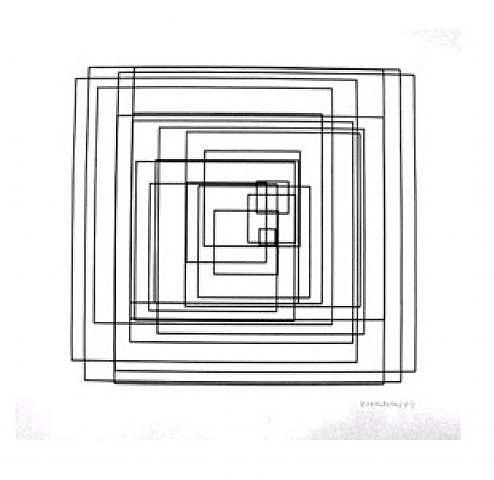
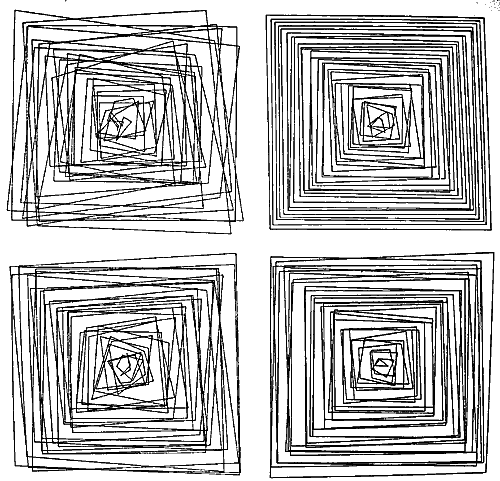
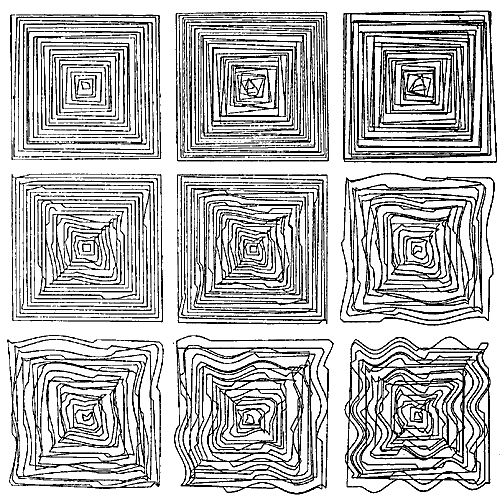
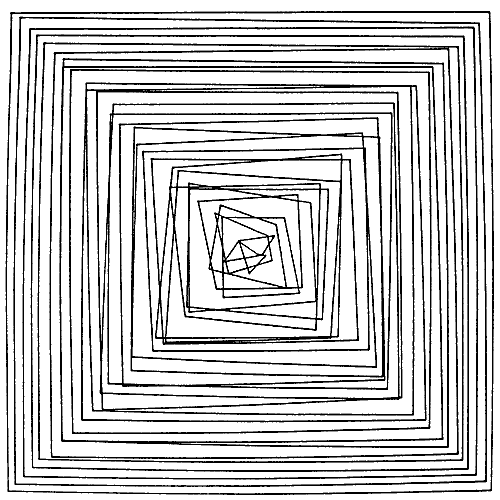
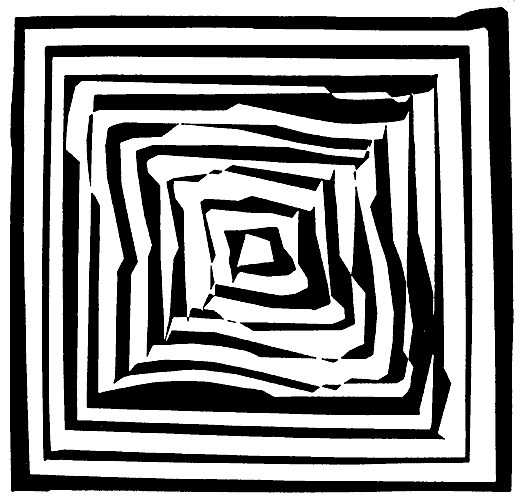
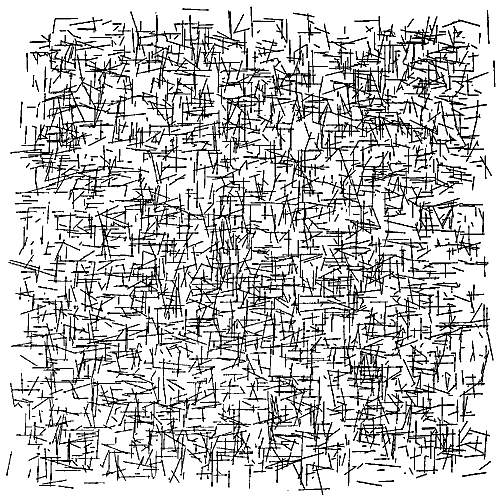 Molnar: Du Cycle - Carres Non Concintriques v1, 1974
Molnar: Transformations, 3x, 1974
Molnar: Hypertrasformations, 1974
Molnar: Mondrian Derange, 1974
-
Molnar: Du Cycle - Carres Non Concintriques v1, 1974
Molnar: Transformations, 3x, 1974
Molnar: Hypertrasformations, 1974
Molnar: Mondrian Derange, 1974
-
.jpg) Mohr: Scratch Code Portfolio (detail), 1974-76
The illusion of a 3D cube is evoked by projecting a set of 12 straight lines onto
the 2D drawing plane. Mohr dissolves the 3Dity by taking away edges (lines) of the cube
consecutively and observes the appearance of new, two-dimensional icons.
In addition, he introduces rotations and other transforamtions of the cube to foster
visual ambiguity and instability. The dynamics of this process and its visual invention
are explored systematically, and each result is drawn as part of a cluster of images
representing the complete set of combinations.
"Since 1973, in my research, I have been concentrating on fracturing the symmetry of a cube
(including since 1978 n-dimensional hypercubes),
using the structure of the cube as a 'system' and 'alphabet'.
The disturbance or disintegration of symmetry is the basic generator of new constructions and relationships."
-
Mohr: Scratch Code Portfolio (detail), 1974-76
The illusion of a 3D cube is evoked by projecting a set of 12 straight lines onto
the 2D drawing plane. Mohr dissolves the 3Dity by taking away edges (lines) of the cube
consecutively and observes the appearance of new, two-dimensional icons.
In addition, he introduces rotations and other transforamtions of the cube to foster
visual ambiguity and instability. The dynamics of this process and its visual invention
are explored systematically, and each result is drawn as part of a cluster of images
representing the complete set of combinations.
"Since 1973, in my research, I have been concentrating on fracturing the symmetry of a cube
(including since 1978 n-dimensional hypercubes),
using the structure of the cube as a 'system' and 'alphabet'.
The disturbance or disintegration of symmetry is the basic generator of new constructions and relationships."
-
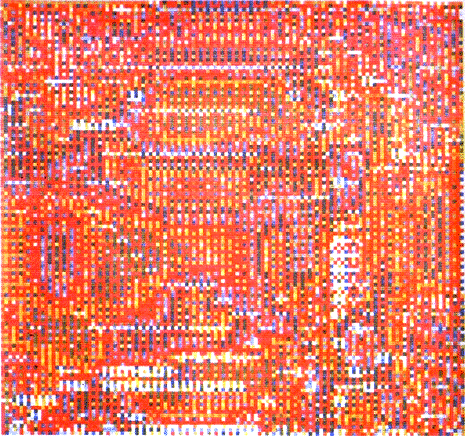
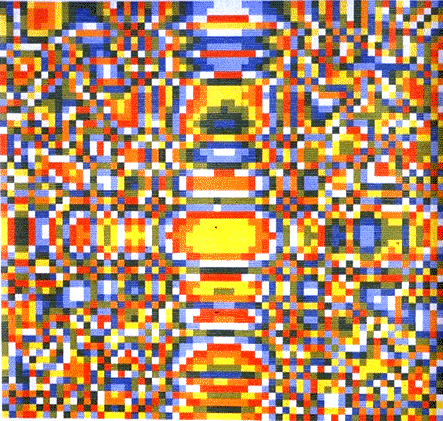
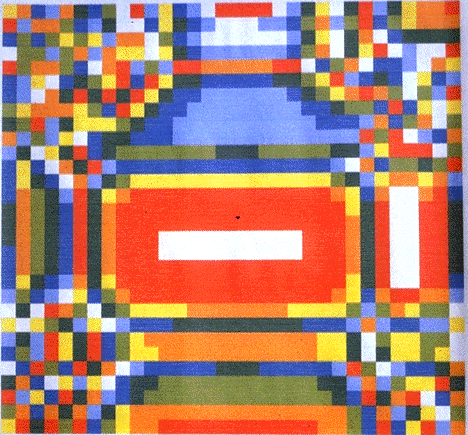
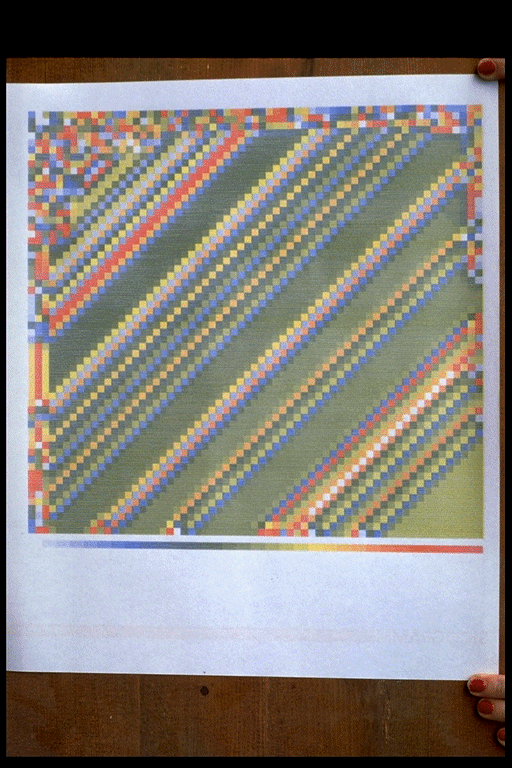 Franke: Colorraster 75, 1975
an edition of the pictures was printed with one of the first
ink jet printer available in Europe.
-
Franke: Colorraster 75, 1975
an edition of the pictures was printed with one of the first
ink jet printer available in Europe.
-
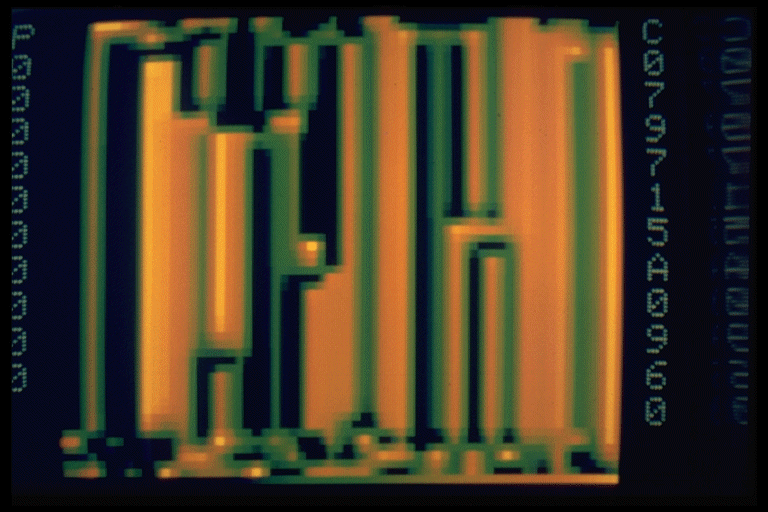
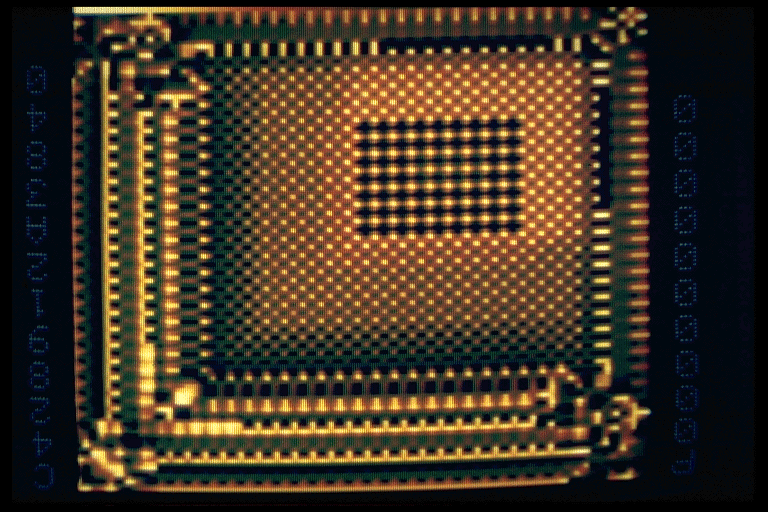
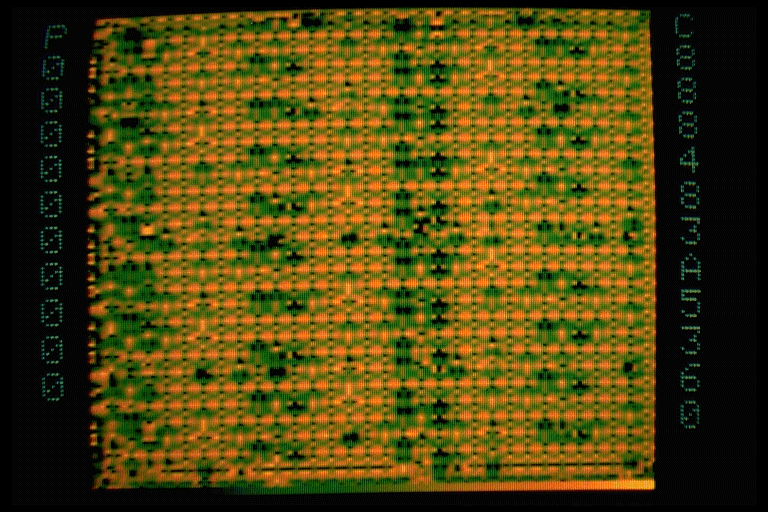 Franke: Green Series, 1975
-
Franke: Green Series, 1975
-
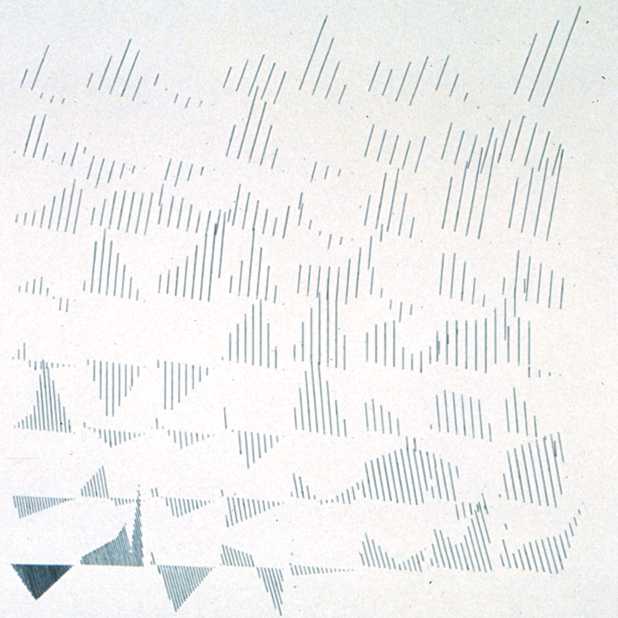
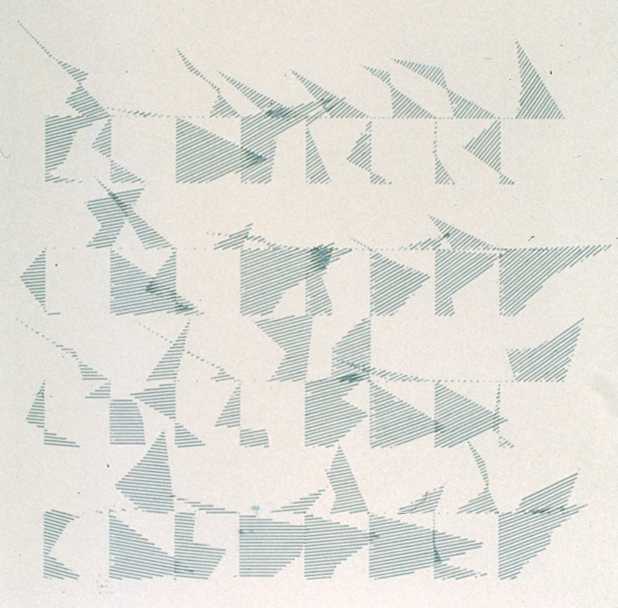
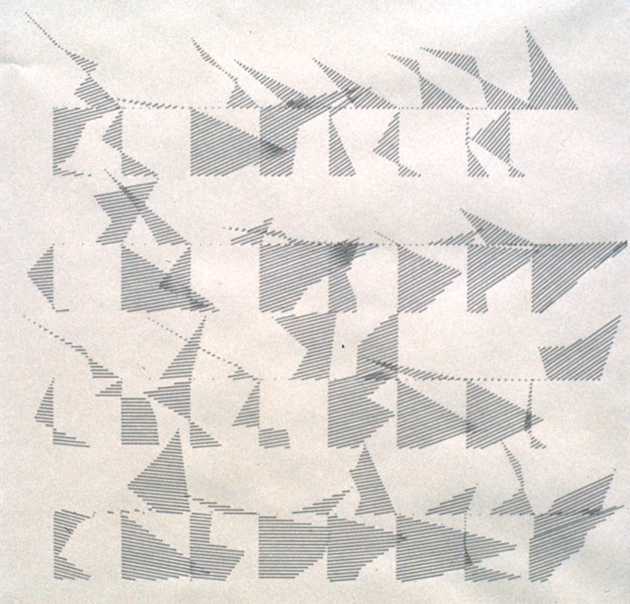
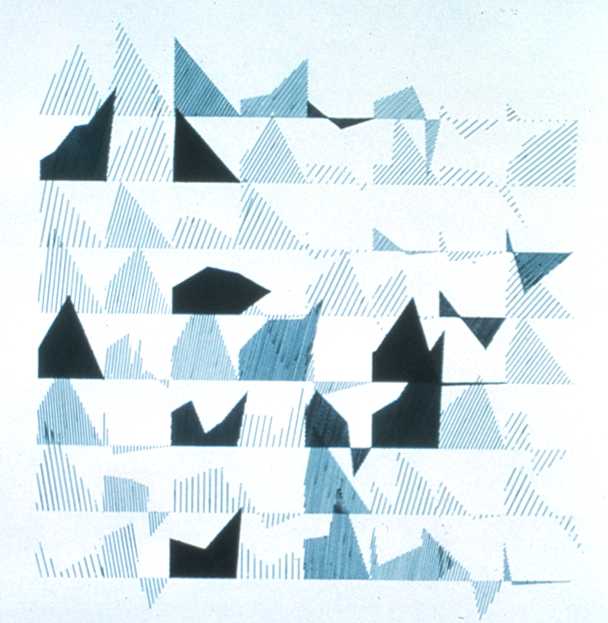
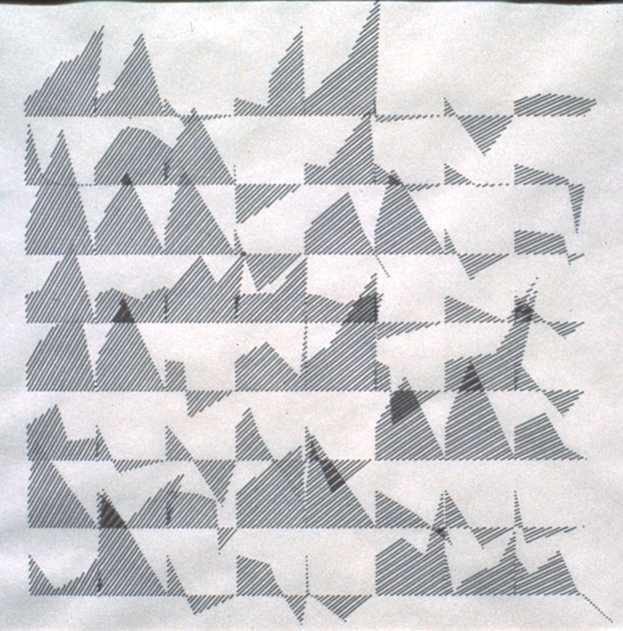
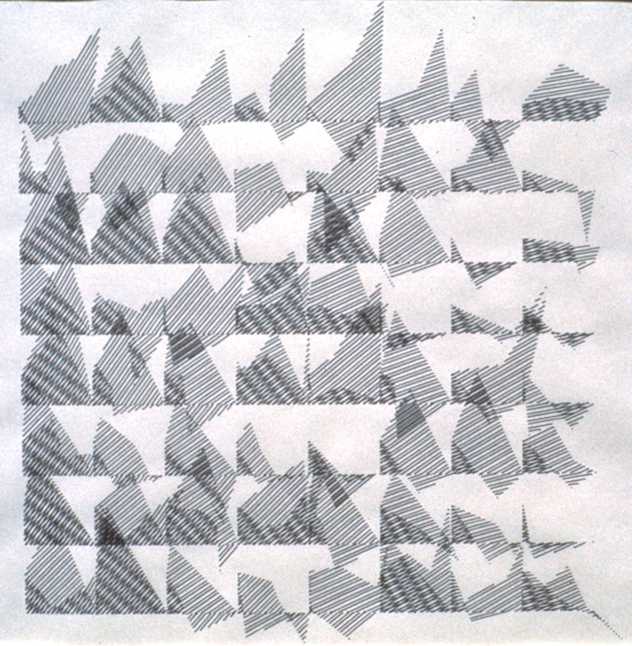 Joan Truckenbrod: Harmonic Coda, 1975
Truckenbrod: Libretto, 1975
Truckenbrod: Poetic Tension, 1975
Truckenbrod: Poesis, 1975
Truckenbrod: Metamorphosis, 1975
Truckenbrod: Lyric Catalyst, 1975
"In my early work, I created a sense of presence of invisible forces in nature. For me, these forces
in nature are metaphors for the interpersonal dynamics between people. I created algorithmic images,
using mathematical descriptions of phenomena such as light reflecting off of irregular sur-faces, that
embodied these dynamic forces. In these drawings, environmental phenomena that we sense, like the wind,
were visualized and given a physical presence. Algorithmic patterns were also created on fabric using
heat-transfer xerography. This mapping of environmental behaviors onto cloth propelled this algorithmic
representation back into the natural world.
I began making digital drawings by programming the computer in FORTRAN programming language.
These early drawings were created using an IBM Mainframe computer and a CalComp Plotter.
The computer processing was done in Batch mode. My computer programs were processed and the
resulting data for the drawings was recorded on a 16 BPI tape. I picked the tape up at the
computer center and hand delivered it to the Geography Department at Northern Illinois
University, who operated the large Calcomp drum. plotter."
-
Joan Truckenbrod: Harmonic Coda, 1975
Truckenbrod: Libretto, 1975
Truckenbrod: Poetic Tension, 1975
Truckenbrod: Poesis, 1975
Truckenbrod: Metamorphosis, 1975
Truckenbrod: Lyric Catalyst, 1975
"In my early work, I created a sense of presence of invisible forces in nature. For me, these forces
in nature are metaphors for the interpersonal dynamics between people. I created algorithmic images,
using mathematical descriptions of phenomena such as light reflecting off of irregular sur-faces, that
embodied these dynamic forces. In these drawings, environmental phenomena that we sense, like the wind,
were visualized and given a physical presence. Algorithmic patterns were also created on fabric using
heat-transfer xerography. This mapping of environmental behaviors onto cloth propelled this algorithmic
representation back into the natural world.
I began making digital drawings by programming the computer in FORTRAN programming language.
These early drawings were created using an IBM Mainframe computer and a CalComp Plotter.
The computer processing was done in Batch mode. My computer programs were processed and the
resulting data for the drawings was recorded on a 16 BPI tape. I picked the tape up at the
computer center and hand delivered it to the Geography Department at Northern Illinois
University, who operated the large Calcomp drum. plotter."
-
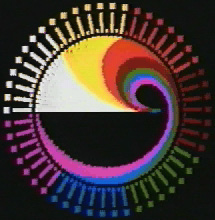 Whitney: Arabesque, 1975
For some Arabesque is considered "the seminal computer film".
Set to the music of Manoochelher Sadeghi, the synaesthetic film ran 7 minutes.
Whitney calls the concept of structuring his computer animations according to
harmonies of the musical scale digital harmony.
-
Whitney: Arabesque, 1975
For some Arabesque is considered "the seminal computer film".
Set to the music of Manoochelher Sadeghi, the synaesthetic film ran 7 minutes.
Whitney calls the concept of structuring his computer animations according to
harmonies of the musical scale digital harmony.
-
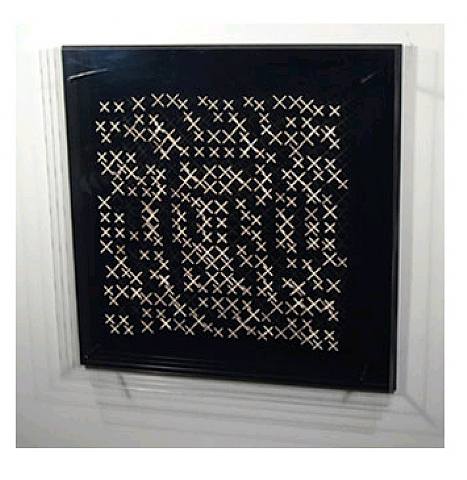 Tony Longson: CRS, 1975
CRS shows two of the recurring themes in his work.
One explores the interplay between 2-D and 3-D visual space (physiologically we are well
equipped to see three dimensions, yet we are trained to interpret grid patterns as 2-D surfaces).
The second exploits our compelling desire to make order out of chaos.
-
Tony Longson: CRS, 1975
CRS shows two of the recurring themes in his work.
One explores the interplay between 2-D and 3-D visual space (physiologically we are well
equipped to see three dimensions, yet we are trained to interpret grid patterns as 2-D surfaces).
The second exploits our compelling desire to make order out of chaos.
-
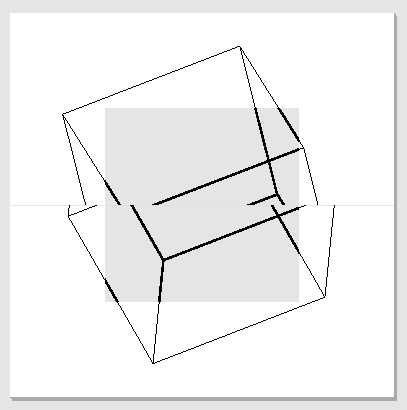
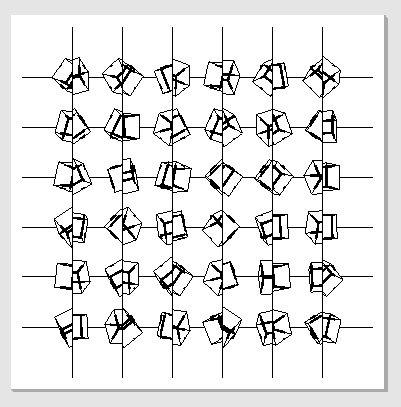
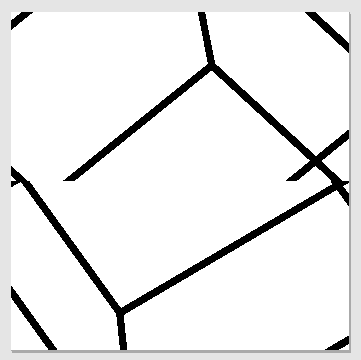 Mohr: P-196/B, P-197/K, P-200/N, 1977
-
Mohr: P-196/B, P-197/K, P-200/N, 1977
-
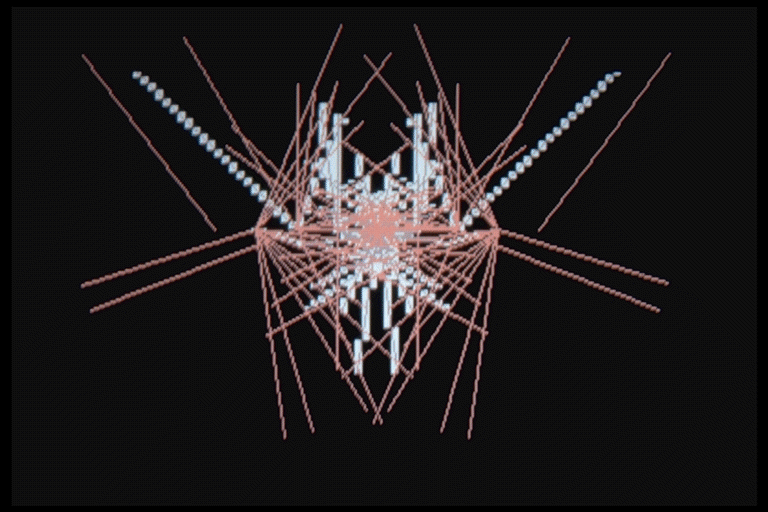
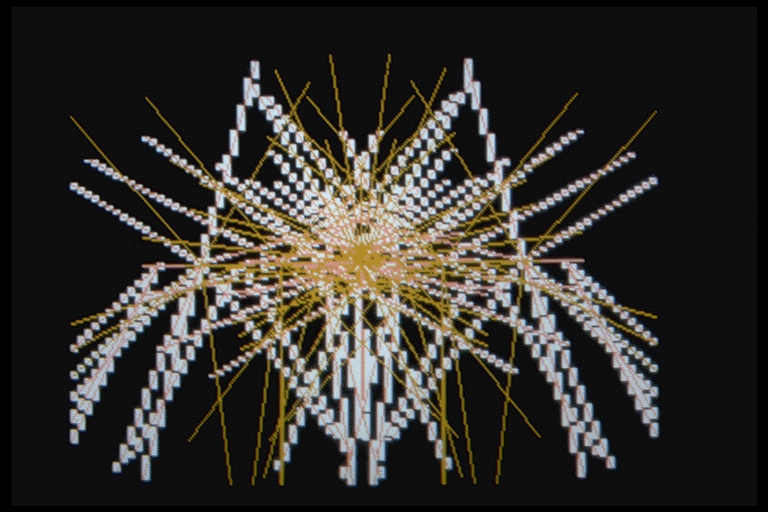
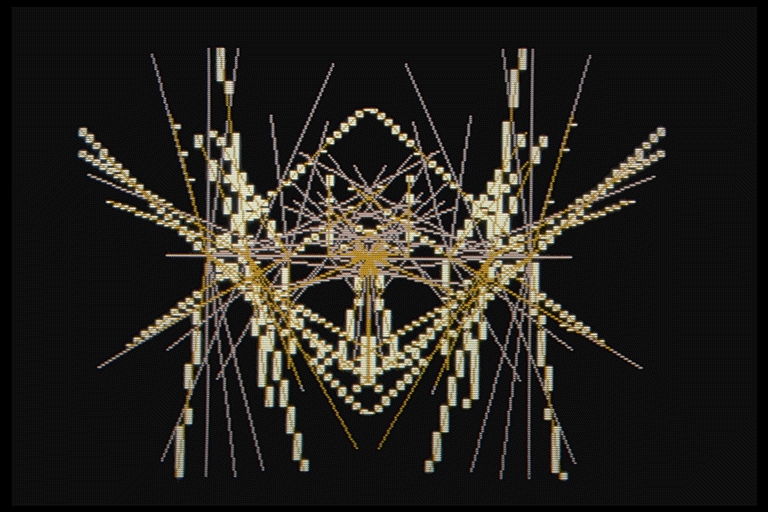
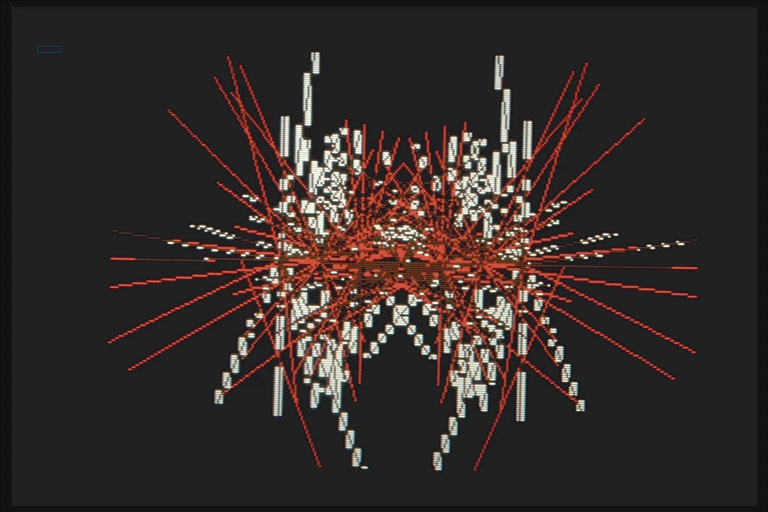 Franke: Cascade, 1978
Live transformation of music into graphics: the underlying program
for a Apple II GS converts sounds in relation to the frequencies into pictures.
-
Franke: Cascade, 1978
Live transformation of music into graphics: the underlying program
for a Apple II GS converts sounds in relation to the frequencies into pictures.
-
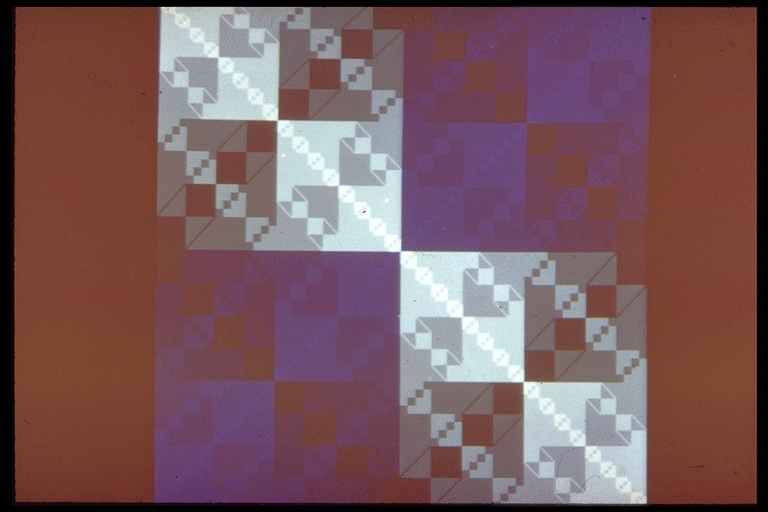
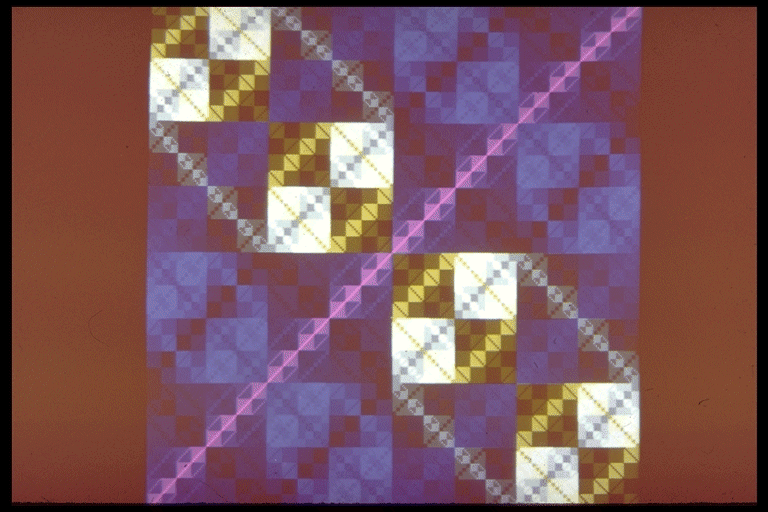
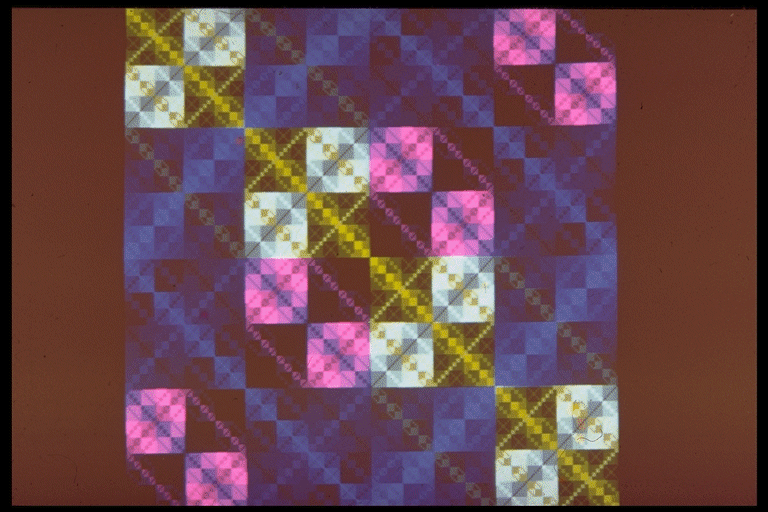
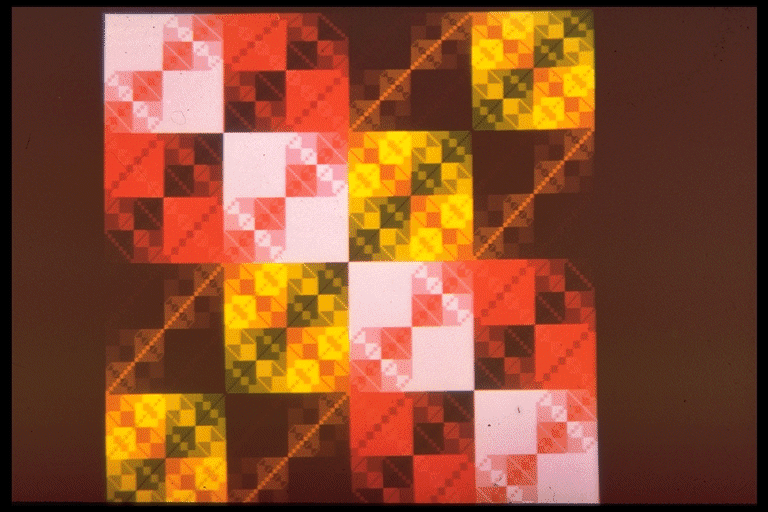 Franke: Cold Logic, 1978
The pictures developed interactively to the music of J.S. Bach and were documented
as music-accompanied animation on video.
-
Franke: Cold Logic, 1978
The pictures developed interactively to the music of J.S. Bach and were documented
as music-accompanied animation on video.
-
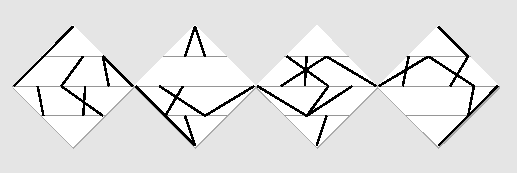
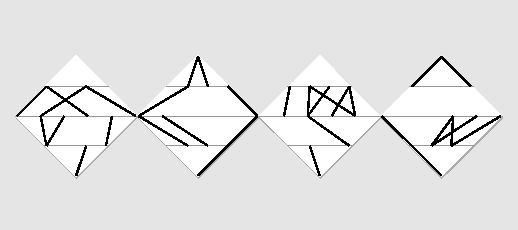
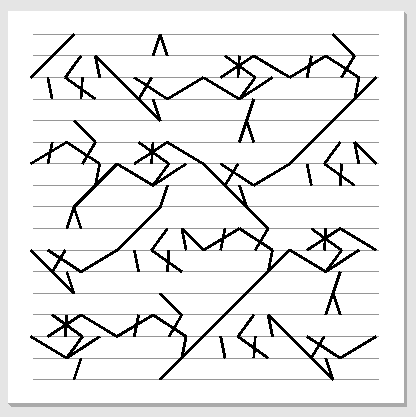
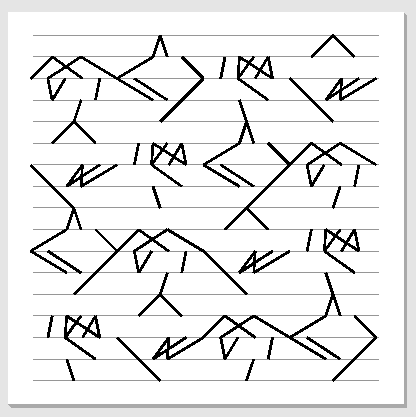
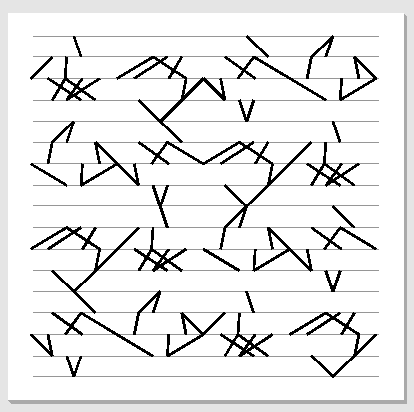 Mohr: P-224/A, P-224/B, P-226/A, P-226/B, P-226/C, 1978
-
Mohr: P-224/A, P-224/B, P-226/A, P-226/B, P-226/C, 1978
-
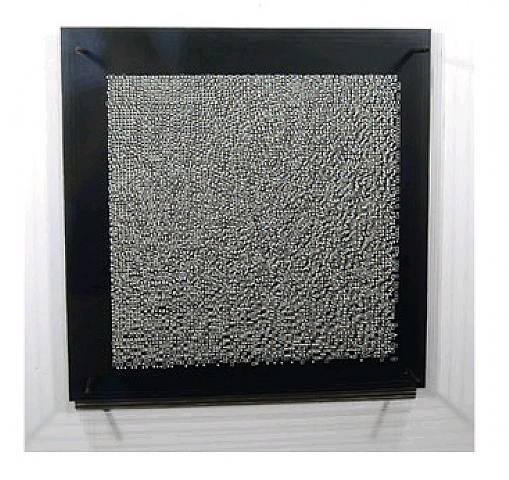 Longson: Square Tonal Drawing, 1978
In Square Tonal Drawing, the visual conflict between 2-D and 3-D is the main theme -
geometric marks form a flat grid pattern when viewed from straight on,
and break apart into a cloud from any other viewpoint.
späť na TRANSLAB[4]
Longson: Square Tonal Drawing, 1978
In Square Tonal Drawing, the visual conflict between 2-D and 3-D is the main theme -
geometric marks form a flat grid pattern when viewed from straight on,
and break apart into a cloud from any other viewpoint.
späť na TRANSLAB[4]


 Ben F Laposky (1914, us): Oscillons, 1952-56
V 1950 začína vytvárať prvé grafické obrazce generované elektronickým analógovým počítačom,
osciloskopom. Tvorené vzory lúčov nahráva na vysokorýchlostný film
a z CRT obrazovky potom produkuje fotografie, oscilóny.
-
Ben F Laposky (1914, us): Oscillons, 1952-56
V 1950 začína vytvárať prvé grafické obrazce generované elektronickým analógovým počítačom,
osciloskopom. Tvorené vzory lúčov nahráva na vysokorýchlostný film
a z CRT obrazovky potom produkuje fotografie, oscilóny.
-



 Herbert Franke (1927, de): Lichtformen, 1953-55
S osciloskopom pracuje aj Franke.
It is worth pointing out another coincidence of the development
of computer art in the US and Germany: the first computer art exhibitions
in the world were held in 1965, in the cities of New York and Stuttgart.
Franke's wide-ranging interests include the use of random-number generators,
image-processing, numerically-controlled machine tools, iterative techniques, fractals
and even a series of experiments with music produced on the self-constructed wind instrument
of colleague Bruno Spoerri.
-
Herbert Franke (1927, de): Lichtformen, 1953-55
S osciloskopom pracuje aj Franke.
It is worth pointing out another coincidence of the development
of computer art in the US and Germany: the first computer art exhibitions
in the world were held in 1965, in the cities of New York and Stuttgart.
Franke's wide-ranging interests include the use of random-number generators,
image-processing, numerically-controlled machine tools, iterative techniques, fractals
and even a series of experiments with music produced on the self-constructed wind instrument
of colleague Bruno Spoerri.
-
 Franke: Oszillogram, 1956
"This little system is a simple analogue computer, specially built by Franz Raimann to help me make
pictures. It is called Oszillogramm because, in principle, the result is the super-position of
two electronic oscillation components. The real picture is in motion, for viewing an old cathode
tube oscilloscope. The photo is a slide made from the screen."
-
Franke: Oszillogram, 1956
"This little system is a simple analogue computer, specially built by Franz Raimann to help me make
pictures. It is called Oszillogramm because, in principle, the result is the super-position of
two electronic oscillation components. The real picture is in motion, for viewing an old cathode
tube oscilloscope. The photo is a slide made from the screen."
-
 William Fetter, 1960
Fetter coined the term computer graphics to describe one of his own creations:
the first ever computer-generated images of the human figure.
Fetter, an employee of Boeing, was trying to find a way to design an airplane cockpit.
The human model is completed in 1964.
-
William Fetter, 1960
Fetter coined the term computer graphics to describe one of his own creations:
the first ever computer-generated images of the human figure.
Fetter, an employee of Boeing, was trying to find a way to design an airplane cockpit.
The human model is completed in 1964.
-



 Franke: Electronic Graphics, 1961-62
-
Franke: Electronic Graphics, 1961-62
-
 A Michael Noll (us): 3-Dimensional Projection of a Rotating 4-Dimensional Hypercube, 1962
Movie prints (16 mm) of his computer-generated animations.
Noll is one of the earliest pioneers to use a digital computer to create patterns
and animations solely for their artistic and aesthetic value.
First computer works created at Bell Labs in Murray Hill, New Jersey during the Summer of 1962.
-
A Michael Noll (us): 3-Dimensional Projection of a Rotating 4-Dimensional Hypercube, 1962
Movie prints (16 mm) of his computer-generated animations.
Noll is one of the earliest pioneers to use a digital computer to create patterns
and animations solely for their artistic and aesthetic value.
First computer works created at Bell Labs in Murray Hill, New Jersey during the Summer of 1962.
-

 Charles Csuri: After Duerer, 1963
Csuri: After Mondrian, 1963
Csuri experimentuje s figurálnymi motívmi.
"In 1963 I made an analogue computer which I used to make transformations on a drawing. I used it
to do a series of drawings based upon the paintings of several old masters. [Klee, Durer, Ingres,
Picasso, Goya, and Mondrian.]"
-
Charles Csuri: After Duerer, 1963
Csuri: After Mondrian, 1963
Csuri experimentuje s figurálnymi motívmi.
"In 1963 I made an analogue computer which I used to make transformations on a drawing. I used it
to do a series of drawings based upon the paintings of several old masters. [Klee, Durer, Ingres,
Picasso, Goya, and Mondrian.]"
-
 Ivan Sutherland: Sketchpad, 1963
Sutherland created a device which made it possible for people to interactively
create images on their computer screens.
Features:
pop-up menus
constraint-based drawing
hierarchical modeling
utilized lightpen for interaction
-
Ivan Sutherland: Sketchpad, 1963
Sutherland created a device which made it possible for people to interactively
create images on their computer screens.
Features:
pop-up menus
constraint-based drawing
hierarchical modeling
utilized lightpen for interaction
-
 Kenneth Knowlton + Lillian Schwartz (us): Pixillation, 1963
Stills from Pixillation, programmed in BEFLIX.
BEFLIX is the name of the first specialised computer animation language.
BEFLIX was invented by Kenneth C. Knowlton at Bell Telephone Laboratories, USA.
BEFLIX was invented in 1963.
BEFLIX is a corruption of Bell Flicks.
BEFLIX produced images at a resolution of 252 x 184 in 8 shades of grey.
BEFLIX-generated films, created using an IBM 7094 computer and Stromberg-Carlson
4020 microfilm recorder, cost approximately $500 per minute of output.
BEFLIX operations were:
Draw straight lines (from dots).
Draw curves.
Copy region.
Move region.
Solid fill area.
Zoom area.
Dissolve image transition.
Knowlton initially hoped the artists would learn the language to program their own movies,
but he came to realize that they usually wanted to create something the language could
not facilitate, and they also shied away from programming.
Therefore he accommodated the artists by, for example, writing special extensions to BEFLIX
for Stan Vanderbeek, or creating a completely new language, EXPLOR (EXplicit Patterns,
Local Operations and Randomness) for Lillian Schwartz.
-
Kenneth Knowlton + Lillian Schwartz (us): Pixillation, 1963
Stills from Pixillation, programmed in BEFLIX.
BEFLIX is the name of the first specialised computer animation language.
BEFLIX was invented by Kenneth C. Knowlton at Bell Telephone Laboratories, USA.
BEFLIX was invented in 1963.
BEFLIX is a corruption of Bell Flicks.
BEFLIX produced images at a resolution of 252 x 184 in 8 shades of grey.
BEFLIX-generated films, created using an IBM 7094 computer and Stromberg-Carlson
4020 microfilm recorder, cost approximately $500 per minute of output.
BEFLIX operations were:
Draw straight lines (from dots).
Draw curves.
Copy region.
Move region.
Solid fill area.
Zoom area.
Dissolve image transition.
Knowlton initially hoped the artists would learn the language to program their own movies,
but he came to realize that they usually wanted to create something the language could
not facilitate, and they also shied away from programming.
Therefore he accommodated the artists by, for example, writing special extensions to BEFLIX
for Stan Vanderbeek, or creating a completely new language, EXPLOR (EXplicit Patterns,
Local Operations and Randomness) for Lillian Schwartz.
-

 Noll: Gaussian Quadratic, 1963
Ninety-nine lines connect 100 points whose horizontal coordinates are Gaussian.
Vertical coordinates increase according to a quadratic equation.
As a point reaches the top, it is reflected to the bottom to continue its rise.
The exact proportions of this pattern were chosen from many other examples.
www.citi.columbia.edu/amnoll/CompArtExamples.html
Noll: Gaussian Quadratic, 1963
Ninety-nine lines connect 100 points whose horizontal coordinates are Gaussian.
Vertical coordinates increase according to a quadratic equation.
As a point reaches the top, it is reflected to the bottom to continue its rise.
The exact proportions of this pattern were chosen from many other examples.
www.citi.columbia.edu/amnoll/CompArtExamples.html  -
-



 John Whitney sr: Lapis, 1963-66
16mm farebný film Lapis vytvára Whitney na analógovom počítači.
-
John Whitney sr: Lapis, 1963-66
16mm farebný film Lapis vytvára Whitney na analógovom počítači.
-

 Noll: Computer Composition With Lines, 1964
Noll: Four Computer-Generated Random Patterns Based on the Composition Criteria Of Mondrian's Composition With Lines, 1964
Algorithmic simulation of Mondrian’s painting Composition With Lines
created with pseudorandom numbers.
When xerographic reproductions of both works were shown to 100 people,
the computer-generated picture was preferred to Mondrian by 59.
This early investigation of the aesthetics of computer art has become a classic
and is described in the published paper by Noll,
Human or Machine: A Subjective Comparison of Piet Mondrian's ‘Composition with Lines’
and a Computer–Generated Picture, The Psychological Record, Vol. 16. No. 1,
(January 1966), pp. 1-10.
-
Noll: Computer Composition With Lines, 1964
Noll: Four Computer-Generated Random Patterns Based on the Composition Criteria Of Mondrian's Composition With Lines, 1964
Algorithmic simulation of Mondrian’s painting Composition With Lines
created with pseudorandom numbers.
When xerographic reproductions of both works were shown to 100 people,
the computer-generated picture was preferred to Mondrian by 59.
This early investigation of the aesthetics of computer art has become a classic
and is described in the published paper by Noll,
Human or Machine: A Subjective Comparison of Piet Mondrian's ‘Composition with Lines’
and a Computer–Generated Picture, The Psychological Record, Vol. 16. No. 1,
(January 1966), pp. 1-10.
-
 Noll: Vertical-Horizontal No. 3, 1964
The position of the end points of the lines was chosen at random with a uniform probability density.
One of the coordinates was then changed alternately to create horizontal and vertical lines.
-
Noll: Vertical-Horizontal No. 3, 1964
The position of the end points of the lines was chosen at random with a uniform probability density.
One of the coordinates was then changed alternately to create horizontal and vertical lines.
-
 Stan Vanderbeek + Kenneth Knowlton: Poem Fields, 1964
A geometric moving digital tapestry conceived and made entirely on computer.
Made in Bell Labs.
-
1965
First three public exhibitions of computer art:
Feb 5-19, Generative Computergrafik. Studien-Galerie des Studium Generale, Technische Hochschule Stuttgart.
held by Frieder Nake and Georg Nees (de).
Opened by Max Bense (de).
Apr 6-24, Computer-generated pictures. Howard Wise Gallery, New York (us)
held by A Michael Noll, Bela Julesz (both Bell Labs).
Nov 5-26, Computergrafik. Galerie Wendelin Niedlich, Stuttgart.
held by Frieder Nake and Georg Nees (de).
Opened by Max Bense (de)
Vystavujú nie profesionálni umelci, ale matematici a programátori.
Prácami sú najmä paralely k dielam konštruktivistov, suprematistov či op-artu.
-
Stan Vanderbeek + Kenneth Knowlton: Poem Fields, 1964
A geometric moving digital tapestry conceived and made entirely on computer.
Made in Bell Labs.
-
1965
First three public exhibitions of computer art:
Feb 5-19, Generative Computergrafik. Studien-Galerie des Studium Generale, Technische Hochschule Stuttgart.
held by Frieder Nake and Georg Nees (de).
Opened by Max Bense (de).
Apr 6-24, Computer-generated pictures. Howard Wise Gallery, New York (us)
held by A Michael Noll, Bela Julesz (both Bell Labs).
Nov 5-26, Computergrafik. Galerie Wendelin Niedlich, Stuttgart.
held by Frieder Nake and Georg Nees (de).
Opened by Max Bense (de)
Vystavujú nie profesionálni umelci, ale matematici a programátori.
Prácami sú najmä paralely k dielam konštruktivistov, suprematistov či op-artu.
-

 Frieder Nake: 13/9/1965, Nr 2 & 7, 1965
As a student of mathematics, he was interested in probability theory, and in random numbers in particular.
During that time, he visited philosopher Max Bense from whom he was influenced by.
His interest in philosophy and mathematics began to merge as he started to experiment with drawing software.
Vytvára paralely k dielam Hansa Hartunga a Paula Kleeho.
One of the works shown at the Stuttgart exhibition was entitled Homage a Paul Klee.
Klee’s drawings inspired him to think about programming visual art as a tension between macro and
microaesthetics. They were based on linear structural elements that stretched out across the entire
format but also allowed for smaller groups and gatherings of intricate local graphics.
Nake developed the language COMPARTER ER 56 referring to the Standard Elektric ER 56 computer,
for which it was written. ER 56 contained three subpackages, a space organizer, a set of different
random number generators, and selectors for the repertoire of graphic elements.
Program chose a stochastic matrix, raised the quantities to powers,
and then visualized the numerical results by allocating characters or colours according to their amount.
-
Frieder Nake: 13/9/1965, Nr 2 & 7, 1965
As a student of mathematics, he was interested in probability theory, and in random numbers in particular.
During that time, he visited philosopher Max Bense from whom he was influenced by.
His interest in philosophy and mathematics began to merge as he started to experiment with drawing software.
Vytvára paralely k dielam Hansa Hartunga a Paula Kleeho.
One of the works shown at the Stuttgart exhibition was entitled Homage a Paul Klee.
Klee’s drawings inspired him to think about programming visual art as a tension between macro and
microaesthetics. They were based on linear structural elements that stretched out across the entire
format but also allowed for smaller groups and gatherings of intricate local graphics.
Nake developed the language COMPARTER ER 56 referring to the Standard Elektric ER 56 computer,
for which it was written. ER 56 contained three subpackages, a space organizer, a set of different
random number generators, and selectors for the repertoire of graphic elements.
Program chose a stochastic matrix, raised the quantities to powers,
and then visualized the numerical results by allocating characters or colours according to their amount.
-


 John Stehura: Cybernetik 5.3, 1965-69
Film realised entirely using programming.
-
John Stehura: Cybernetik 5.3, 1965-69
Film realised entirely using programming.
-
 Kenneth Knowlton + Leon Harmon: Studies in Perception I, 1966
Automatic digitizing method for images.
Created in Bell Labs, early example of image processing, probably the first computer nude.
Knowlton and Harmon scanned a photograph with a special camera, converted analog voltages
to binary numbers, which were stored on magnetic tape.
Another program assigned typographic symbols to these numbers according to halftone densities.
Finally printed by a microfilm plotter.
Exhibited in The Machine show in MoMA in 1968.
-
Kenneth Knowlton + Leon Harmon: Studies in Perception I, 1966
Automatic digitizing method for images.
Created in Bell Labs, early example of image processing, probably the first computer nude.
Knowlton and Harmon scanned a photograph with a special camera, converted analog voltages
to binary numbers, which were stored on magnetic tape.
Another program assigned typographic symbols to these numbers according to halftone densities.
Finally printed by a microfilm plotter.
Exhibited in The Machine show in MoMA in 1968.
-


 Whitney: Permutations, 1967
Film constructed entirely off the black-and-white monitor of a large computer system
(IBM 360, IBM 2250 Display, written in GRAF and FORTRAN).
Color was added by editing with an optical printer.
It is an elegant abstract work composed of architectures of color dots that develop pattern
while displaying a kinetic rhythm.
-
1968
August 2 - October 20
Cybernetic Serendipity: The Computer and the Arts exhibition is held
at the Institute of Contemporary Art, London,
curated by Jasia Reichardt (ICA director)
and advised by Max Bense.
Exhibition draws 60,000 people in 2 months.
Works include plotter drawings, computer prints, verses, films, sculpture, music and robots.
Three sections:
1st consisted of computer generated graphics, computer animated films, computer composed and played music, and computer verse and texts.
2nd included machines.
3rd included machines demonstrating the uses of computers.
Some More Beginnings show is organized by Experiments in Art and Technology
at the Brooklyn Museum, New York.
-
1968
First two international computer art exhibitions in Czechoslovakia:
Brno, organised by Jiri Valoch (1946, experimental poet),
Počítač a umění, Filmový klub, Praha, organised by Miroslav Klivar (1932)
-
Whitney: Permutations, 1967
Film constructed entirely off the black-and-white monitor of a large computer system
(IBM 360, IBM 2250 Display, written in GRAF and FORTRAN).
Color was added by editing with an optical printer.
It is an elegant abstract work composed of architectures of color dots that develop pattern
while displaying a kinetic rhythm.
-
1968
August 2 - October 20
Cybernetic Serendipity: The Computer and the Arts exhibition is held
at the Institute of Contemporary Art, London,
curated by Jasia Reichardt (ICA director)
and advised by Max Bense.
Exhibition draws 60,000 people in 2 months.
Works include plotter drawings, computer prints, verses, films, sculpture, music and robots.
Three sections:
1st consisted of computer generated graphics, computer animated films, computer composed and played music, and computer verse and texts.
2nd included machines.
3rd included machines demonstrating the uses of computers.
Some More Beginnings show is organized by Experiments in Art and Technology
at the Brooklyn Museum, New York.
-
1968
First two international computer art exhibitions in Czechoslovakia:
Brno, organised by Jiri Valoch (1946, experimental poet),
Počítač a umění, Filmový klub, Praha, organised by Miroslav Klivar (1932)
-
 Csuri: Random War, 1968
"A drawing was made of a single toy soldier and this became a data set. The computer program
used a random number generator. The random numbers determined the distribution and position of
400 soldiers on a battlefield. A transformatation involving rotations was used to determine the
angle of each soldier. One side was called the 'Red' and the other one the 'Black' and the names
of real people were given to the program. Another program assigned military rands and army serial
numbers also at random. The random number generator decided the following information.
(1) Dead
(2) Wounded
(3) Missing
(4) Survivors
(5) One Hero for Each Side
(6) Medals for Valor
(7) Good Conduct
(8) Efficiency Medals"
-
Csuri: Random War, 1968
"A drawing was made of a single toy soldier and this became a data set. The computer program
used a random number generator. The random numbers determined the distribution and position of
400 soldiers on a battlefield. A transformatation involving rotations was used to determine the
angle of each soldier. One side was called the 'Red' and the other one the 'Black' and the names
of real people were given to the program. Another program assigned military rands and army serial
numbers also at random. The random number generator decided the following information.
(1) Dead
(2) Wounded
(3) Missing
(4) Survivors
(5) One Hero for Each Side
(6) Medals for Valor
(7) Good Conduct
(8) Efficiency Medals"
-
 Csuri: Aging Process, 1968
"Two drawings were digitized, one of a young girl and the other of an old woman. The program
starts with the young girl and then in stages moves it toward the older woman. Gradually the
drawing is fragmented with a greater displacement as it reaches the center. Then the fragments
begin to incrementally change their shape until the drawing of the woman is realized. This process
was used to create a short animation sequence and it was probably more effective as an animation
rather than a still image."
-
Csuri: Aging Process, 1968
"Two drawings were digitized, one of a young girl and the other of an old woman. The program
starts with the young girl and then in stages moves it toward the older woman. Gradually the
drawing is fragmented with a greater displacement as it reaches the center. Then the fragments
begin to incrementally change their shape until the drawing of the woman is realized. This process
was used to create a short animation sequence and it was probably more effective as an animation
rather than a still image."
-
 Tony Pritchett: Flexipede, 1968
One of the first examples of digital film.
It took several months to make during 1966 and 67,
using the London University Atlas computer (a supercomputer in those days, with 128K of online memory),
programmed in Fortran on punched cards with a 2-hour turn-around time,
and output on the first microfilm recorder in the UK.
The microfilm recorder was only capable of drawing black lines on to a square area of the film frame,
which accounts for its rather restricted graphic style.
-
Tony Pritchett: Flexipede, 1968
One of the first examples of digital film.
It took several months to make during 1966 and 67,
using the London University Atlas computer (a supercomputer in those days, with 128K of online memory),
programmed in Fortran on punched cards with a 2-hour turn-around time,
and output on the first microfilm recorder in the UK.
The microfilm recorder was only capable of drawing black lines on to a square area of the film frame,
which accounts for its rather restricted graphic style.
-
.gif) Georg Nees: Wurfel-Unordnung (Cubic Disarray), 1968-71
Nees' plotter piece remains a poetically elegant computer graphic rendering of order and chaos.
-
Georg Nees: Wurfel-Unordnung (Cubic Disarray), 1968-71
Nees' plotter piece remains a poetically elegant computer graphic rendering of order and chaos.
-
 Vera Molnar (1924, hu): Interruptions, 1968-69
In 1968, she began using a computer to assist her art making.
She creates non-figurative, geometric drawings by using computer and pen plotter.
The computer’s ability to produce an infinite number of random and calculated images and record them
would provide artists with enormous data bank for creativity.
Just like the traditional painter, Klee and Kandinsky tried to visualize the hidden force in nature
or in their mind, Molnar believes the computer could help artist reveal the hidden force
behind their creativity.
-
Vera Molnar (1924, hu): Interruptions, 1968-69
In 1968, she began using a computer to assist her art making.
She creates non-figurative, geometric drawings by using computer and pen plotter.
The computer’s ability to produce an infinite number of random and calculated images and record them
would provide artists with enormous data bank for creativity.
Just like the traditional painter, Klee and Kandinsky tried to visualize the hidden force in nature
or in their mind, Molnar believes the computer could help artist reveal the hidden force
behind their creativity.
-
.jpg)
.jpg) Edward Zajec (1938, IT): Prostor p1 v13 & v19, 1969-70
The Prostor series implement a balanced interplay
between the deterministic and random parts,
and aim to avoid the tile-effect so common in compositions based on a rectangular grid.
pri každom spustení programu je východiskovou štruktúrou prázdny štvorec,
ktorý program člení podľa vložených harmonických proporcií.
vnútro štvorca sa vypĺňa štyrmi základnými elementami –
vertikálnou, horizontálnou, diagonálnou líniou a sínusovou krivkou.
dĺžka a nadväznosť segmentov je určená na základe pravidiel.
Each time program runs, it defines a rectangle and subdivides it according to harmonic proportions.
The figure formation inside this composition takes place by selecting successively a line
from this set: vertical, horizontal, diagonal and sinusoidal.
The parameters for length and amplitude comply with harmonic ratios.
The lines connect with each other according to predetermined rules.
-
Edward Zajec (1938, IT): Prostor p1 v13 & v19, 1969-70
The Prostor series implement a balanced interplay
between the deterministic and random parts,
and aim to avoid the tile-effect so common in compositions based on a rectangular grid.
pri každom spustení programu je východiskovou štruktúrou prázdny štvorec,
ktorý program člení podľa vložených harmonických proporcií.
vnútro štvorca sa vypĺňa štyrmi základnými elementami –
vertikálnou, horizontálnou, diagonálnou líniou a sínusovou krivkou.
dĺžka a nadväznosť segmentov je určená na základe pravidiel.
Each time program runs, it defines a rectangle and subdivides it according to harmonic proportions.
The figure formation inside this composition takes place by selecting successively a line
from this set: vertical, horizontal, diagonal and sinusoidal.
The parameters for length and amplitude comply with harmonic ratios.
The lines connect with each other according to predetermined rules.
-



 Zajec: RAM 10/3, 10/4, 2/6, 2/9, 1969
The RAM compositions are examples of Zajec's first work done on an IBM 1620 computer.
Linear elements are distributed on a rectangular lattice in different spatial and rhythmic
combinations according to varying probabilities of occurrence.
-
Zajec: RAM 10/3, 10/4, 2/6, 2/9, 1969
The RAM compositions are examples of Zajec's first work done on an IBM 1620 computer.
Linear elements are distributed on a rectangular lattice in different spatial and rhythmic
combinations according to varying probabilities of occurrence.
-
Series.gif)
Series.2.gif) Franke + Peter Henne: CAES (Curves, aesthetics), 1969
-
Franke + Peter Henne: CAES (Curves, aesthetics), 1969
-



 Manfred Mohr (1938, de): P-021/A & P-021/B, Scratch Code, 1969
Mohr: P-049/R & P-050/R, 1970
With this work phase (1969-72), a logical and automatic construction of pictures is introduced into
Mohr's work. For the first time algorithms (rules with a beginning and an ending) are used to calculate
the images.
Individual algorithms are invented for each work from which all forms and structures are solely
generated. The algorithms are built from imposed as well as from random selection principles which
Mohr calls aesthetical-filters.
www.dam.org/mohr/artworks.htm
Manfred Mohr (1938, de): P-021/A & P-021/B, Scratch Code, 1969
Mohr: P-049/R & P-050/R, 1970
With this work phase (1969-72), a logical and automatic construction of pictures is introduced into
Mohr's work. For the first time algorithms (rules with a beginning and an ending) are used to calculate
the images.
Individual algorithms are invented for each work from which all forms and structures are solely
generated. The algorithms are built from imposed as well as from random selection principles which
Mohr calls aesthetical-filters.
www.dam.org/mohr/artworks.htm  -
-



 Franke: Rotationen, Projection, 1970-71
The images are based on interactively controlled motions in perspective view.
This kind of animation sequences were used for the Laser ballet which
was performed on the experimental stage of the bavarian state opera.
-
1971
Worlds first museum based solo exhibition of computer generated art;
Manfred Mohr, Musee d'Art Moderne de la Ville de Paris (France)
-
Franke: Rotationen, Projection, 1970-71
The images are based on interactively controlled motions in perspective view.
This kind of animation sequences were used for the Laser ballet which
was performed on the experimental stage of the bavarian state opera.
-
1971
Worlds first museum based solo exhibition of computer generated art;
Manfred Mohr, Musee d'Art Moderne de la Ville de Paris (France)
-
.jpg)
.jpg)




 Zajec: TVC, 1971
In TVC, the main subject of invention is no longer the design of visual modules, but of procedural ones.
The focus is no longer on the geometry of projection,
but on the grammatical rules that delimit the possible combinations of the constituent elements.
-
Zajec: TVC, 1971
In TVC, the main subject of invention is no longer the design of visual modules, but of procedural ones.
The focus is no longer on the geometry of projection,
but on the grammatical rules that delimit the possible combinations of the constituent elements.
-

 Mark Wilson: Untitled Gray Ground & Untitled Light Gray Ground, 1973
abstract painting involved with complex geometric imagery.
-
Mark Wilson: Untitled Gray Ground & Untitled Light Gray Ground, 1973
abstract painting involved with complex geometric imagery.
-





 Molnar: Du Cycle - Carres Non Concintriques v1, 1974
Molnar: Transformations, 3x, 1974
Molnar: Hypertrasformations, 1974
Molnar: Mondrian Derange, 1974
-
Molnar: Du Cycle - Carres Non Concintriques v1, 1974
Molnar: Transformations, 3x, 1974
Molnar: Hypertrasformations, 1974
Molnar: Mondrian Derange, 1974
-
.jpg) Mohr: Scratch Code Portfolio (detail), 1974-76
The illusion of a 3D cube is evoked by projecting a set of 12 straight lines onto
the 2D drawing plane. Mohr dissolves the 3Dity by taking away edges (lines) of the cube
consecutively and observes the appearance of new, two-dimensional icons.
In addition, he introduces rotations and other transforamtions of the cube to foster
visual ambiguity and instability. The dynamics of this process and its visual invention
are explored systematically, and each result is drawn as part of a cluster of images
representing the complete set of combinations.
"Since 1973, in my research, I have been concentrating on fracturing the symmetry of a cube
(including since 1978 n-dimensional hypercubes),
using the structure of the cube as a 'system' and 'alphabet'.
The disturbance or disintegration of symmetry is the basic generator of new constructions and relationships."
-
Mohr: Scratch Code Portfolio (detail), 1974-76
The illusion of a 3D cube is evoked by projecting a set of 12 straight lines onto
the 2D drawing plane. Mohr dissolves the 3Dity by taking away edges (lines) of the cube
consecutively and observes the appearance of new, two-dimensional icons.
In addition, he introduces rotations and other transforamtions of the cube to foster
visual ambiguity and instability. The dynamics of this process and its visual invention
are explored systematically, and each result is drawn as part of a cluster of images
representing the complete set of combinations.
"Since 1973, in my research, I have been concentrating on fracturing the symmetry of a cube
(including since 1978 n-dimensional hypercubes),
using the structure of the cube as a 'system' and 'alphabet'.
The disturbance or disintegration of symmetry is the basic generator of new constructions and relationships."
-



 Franke: Colorraster 75, 1975
an edition of the pictures was printed with one of the first
ink jet printer available in Europe.
-
Franke: Colorraster 75, 1975
an edition of the pictures was printed with one of the first
ink jet printer available in Europe.
-


 Franke: Green Series, 1975
-
Franke: Green Series, 1975
-





 Joan Truckenbrod: Harmonic Coda, 1975
Truckenbrod: Libretto, 1975
Truckenbrod: Poetic Tension, 1975
Truckenbrod: Poesis, 1975
Truckenbrod: Metamorphosis, 1975
Truckenbrod: Lyric Catalyst, 1975
"In my early work, I created a sense of presence of invisible forces in nature. For me, these forces
in nature are metaphors for the interpersonal dynamics between people. I created algorithmic images,
using mathematical descriptions of phenomena such as light reflecting off of irregular sur-faces, that
embodied these dynamic forces. In these drawings, environmental phenomena that we sense, like the wind,
were visualized and given a physical presence. Algorithmic patterns were also created on fabric using
heat-transfer xerography. This mapping of environmental behaviors onto cloth propelled this algorithmic
representation back into the natural world.
I began making digital drawings by programming the computer in FORTRAN programming language.
These early drawings were created using an IBM Mainframe computer and a CalComp Plotter.
The computer processing was done in Batch mode. My computer programs were processed and the
resulting data for the drawings was recorded on a 16 BPI tape. I picked the tape up at the
computer center and hand delivered it to the Geography Department at Northern Illinois
University, who operated the large Calcomp drum. plotter."
-
Joan Truckenbrod: Harmonic Coda, 1975
Truckenbrod: Libretto, 1975
Truckenbrod: Poetic Tension, 1975
Truckenbrod: Poesis, 1975
Truckenbrod: Metamorphosis, 1975
Truckenbrod: Lyric Catalyst, 1975
"In my early work, I created a sense of presence of invisible forces in nature. For me, these forces
in nature are metaphors for the interpersonal dynamics between people. I created algorithmic images,
using mathematical descriptions of phenomena such as light reflecting off of irregular sur-faces, that
embodied these dynamic forces. In these drawings, environmental phenomena that we sense, like the wind,
were visualized and given a physical presence. Algorithmic patterns were also created on fabric using
heat-transfer xerography. This mapping of environmental behaviors onto cloth propelled this algorithmic
representation back into the natural world.
I began making digital drawings by programming the computer in FORTRAN programming language.
These early drawings were created using an IBM Mainframe computer and a CalComp Plotter.
The computer processing was done in Batch mode. My computer programs were processed and the
resulting data for the drawings was recorded on a 16 BPI tape. I picked the tape up at the
computer center and hand delivered it to the Geography Department at Northern Illinois
University, who operated the large Calcomp drum. plotter."
-
 Whitney: Arabesque, 1975
For some Arabesque is considered "the seminal computer film".
Set to the music of Manoochelher Sadeghi, the synaesthetic film ran 7 minutes.
Whitney calls the concept of structuring his computer animations according to
harmonies of the musical scale digital harmony.
-
Whitney: Arabesque, 1975
For some Arabesque is considered "the seminal computer film".
Set to the music of Manoochelher Sadeghi, the synaesthetic film ran 7 minutes.
Whitney calls the concept of structuring his computer animations according to
harmonies of the musical scale digital harmony.
-
 Tony Longson: CRS, 1975
CRS shows two of the recurring themes in his work.
One explores the interplay between 2-D and 3-D visual space (physiologically we are well
equipped to see three dimensions, yet we are trained to interpret grid patterns as 2-D surfaces).
The second exploits our compelling desire to make order out of chaos.
-
Tony Longson: CRS, 1975
CRS shows two of the recurring themes in his work.
One explores the interplay between 2-D and 3-D visual space (physiologically we are well
equipped to see three dimensions, yet we are trained to interpret grid patterns as 2-D surfaces).
The second exploits our compelling desire to make order out of chaos.
-


 Mohr: P-196/B, P-197/K, P-200/N, 1977
-
Mohr: P-196/B, P-197/K, P-200/N, 1977
-



 Franke: Cascade, 1978
Live transformation of music into graphics: the underlying program
for a Apple II GS converts sounds in relation to the frequencies into pictures.
-
Franke: Cascade, 1978
Live transformation of music into graphics: the underlying program
for a Apple II GS converts sounds in relation to the frequencies into pictures.
-



 Franke: Cold Logic, 1978
The pictures developed interactively to the music of J.S. Bach and were documented
as music-accompanied animation on video.
-
Franke: Cold Logic, 1978
The pictures developed interactively to the music of J.S. Bach and were documented
as music-accompanied animation on video.
-




 Mohr: P-224/A, P-224/B, P-226/A, P-226/B, P-226/C, 1978
-
Mohr: P-224/A, P-224/B, P-226/A, P-226/B, P-226/C, 1978
-
 Longson: Square Tonal Drawing, 1978
In Square Tonal Drawing, the visual conflict between 2-D and 3-D is the main theme -
geometric marks form a flat grid pattern when viewed from straight on,
and break apart into a cloud from any other viewpoint.
späť na TRANSLAB[4]
Longson: Square Tonal Drawing, 1978
In Square Tonal Drawing, the visual conflict between 2-D and 3-D is the main theme -
geometric marks form a flat grid pattern when viewed from straight on,
and break apart into a cloud from any other viewpoint.
späť na TRANSLAB[4]